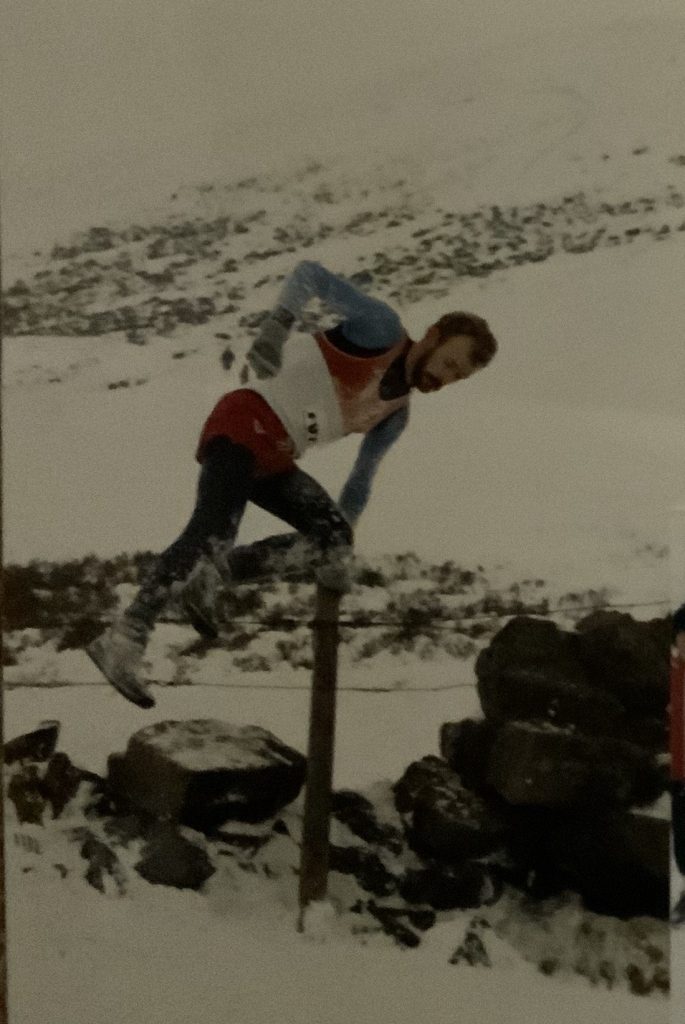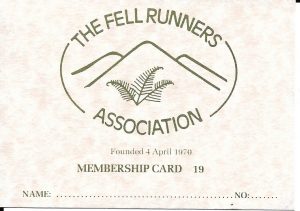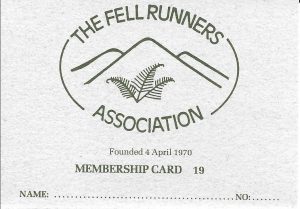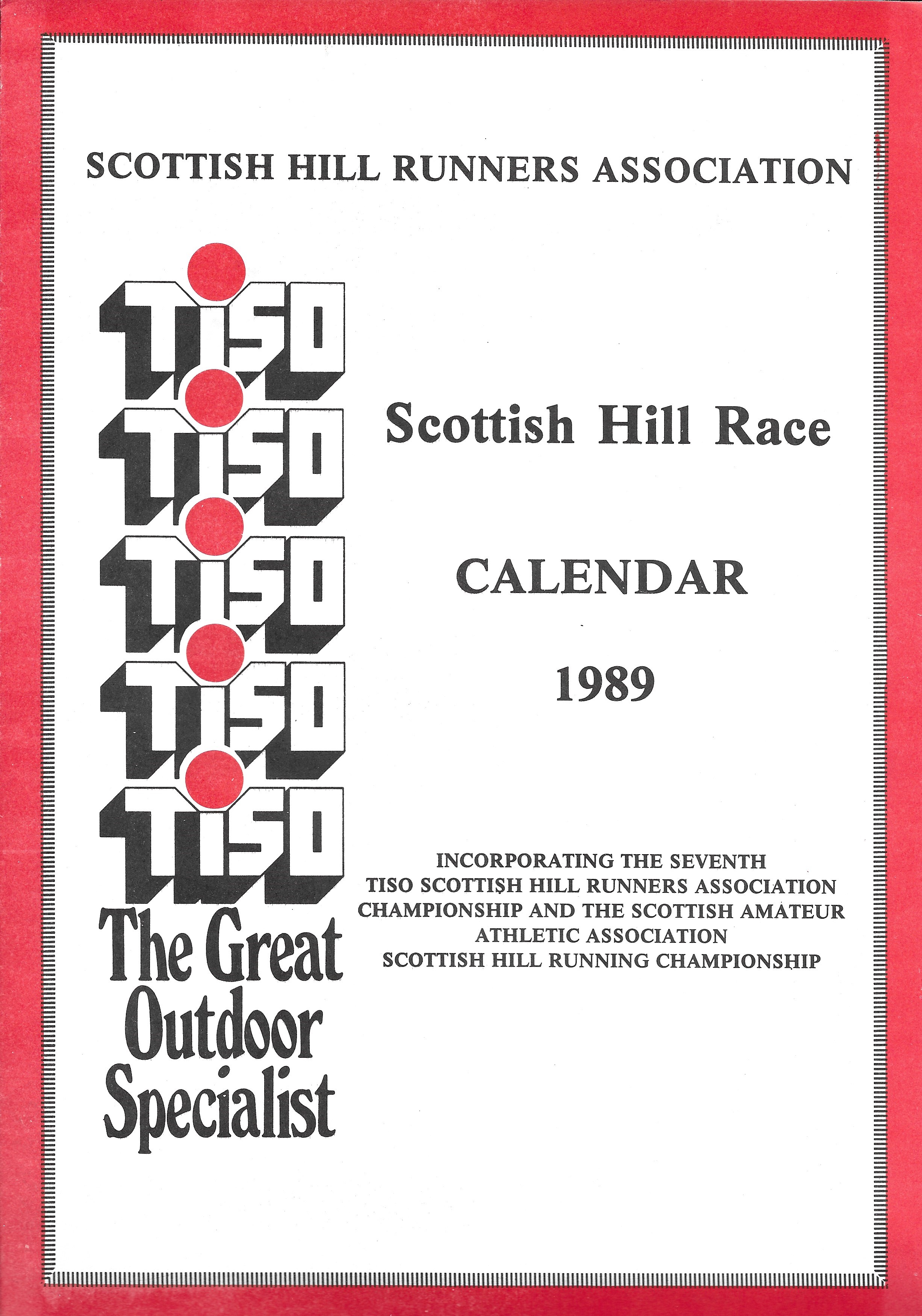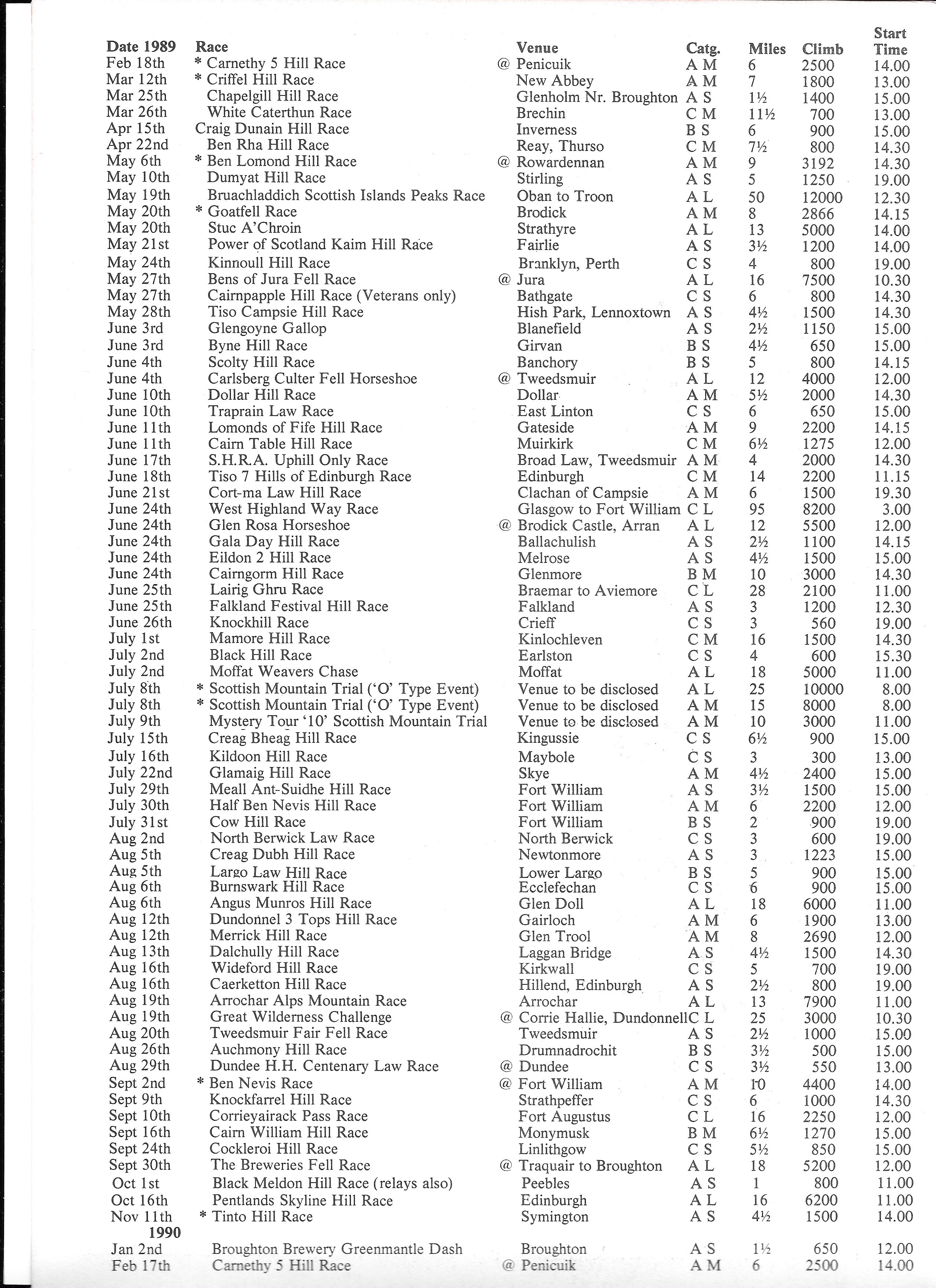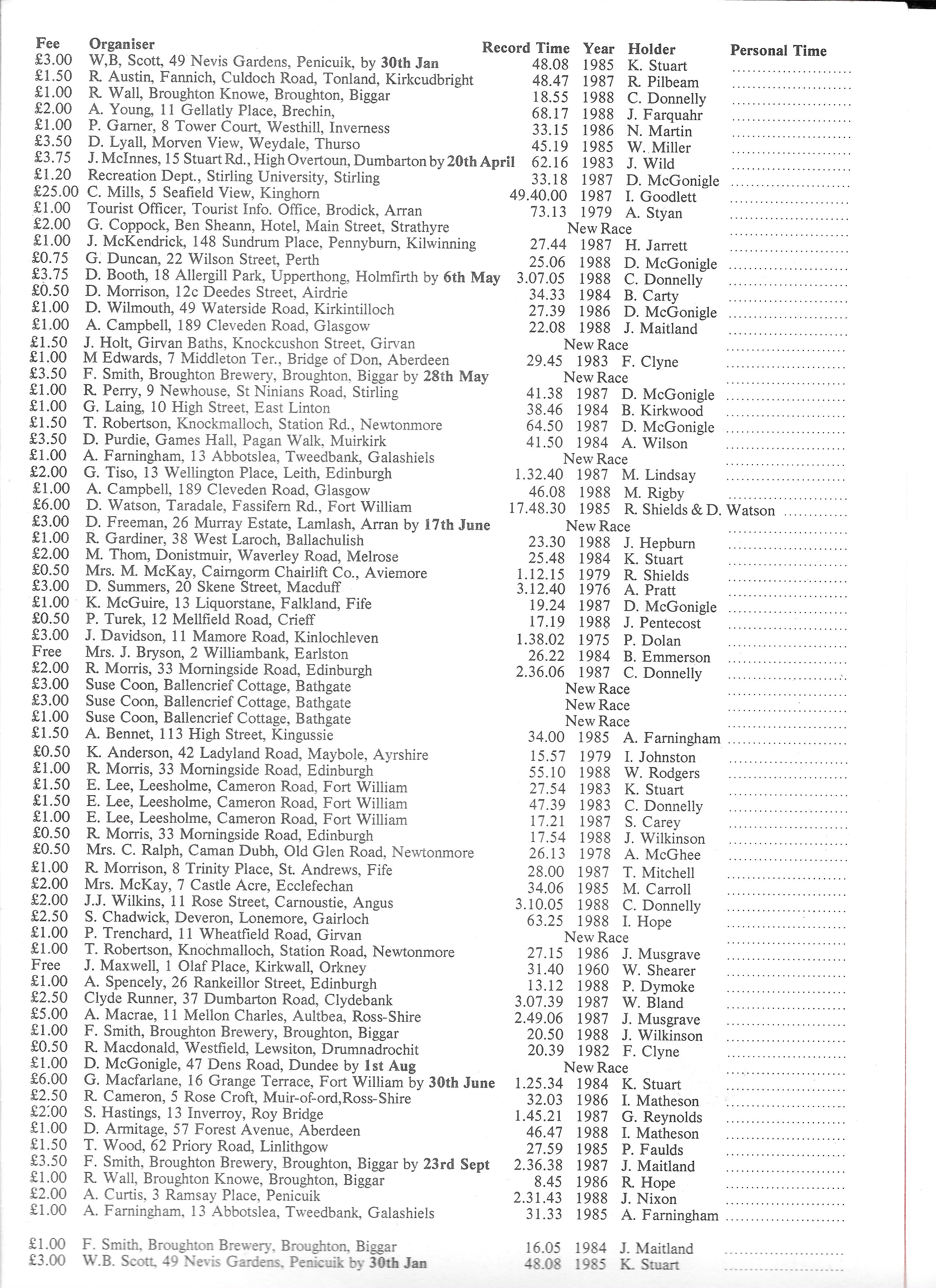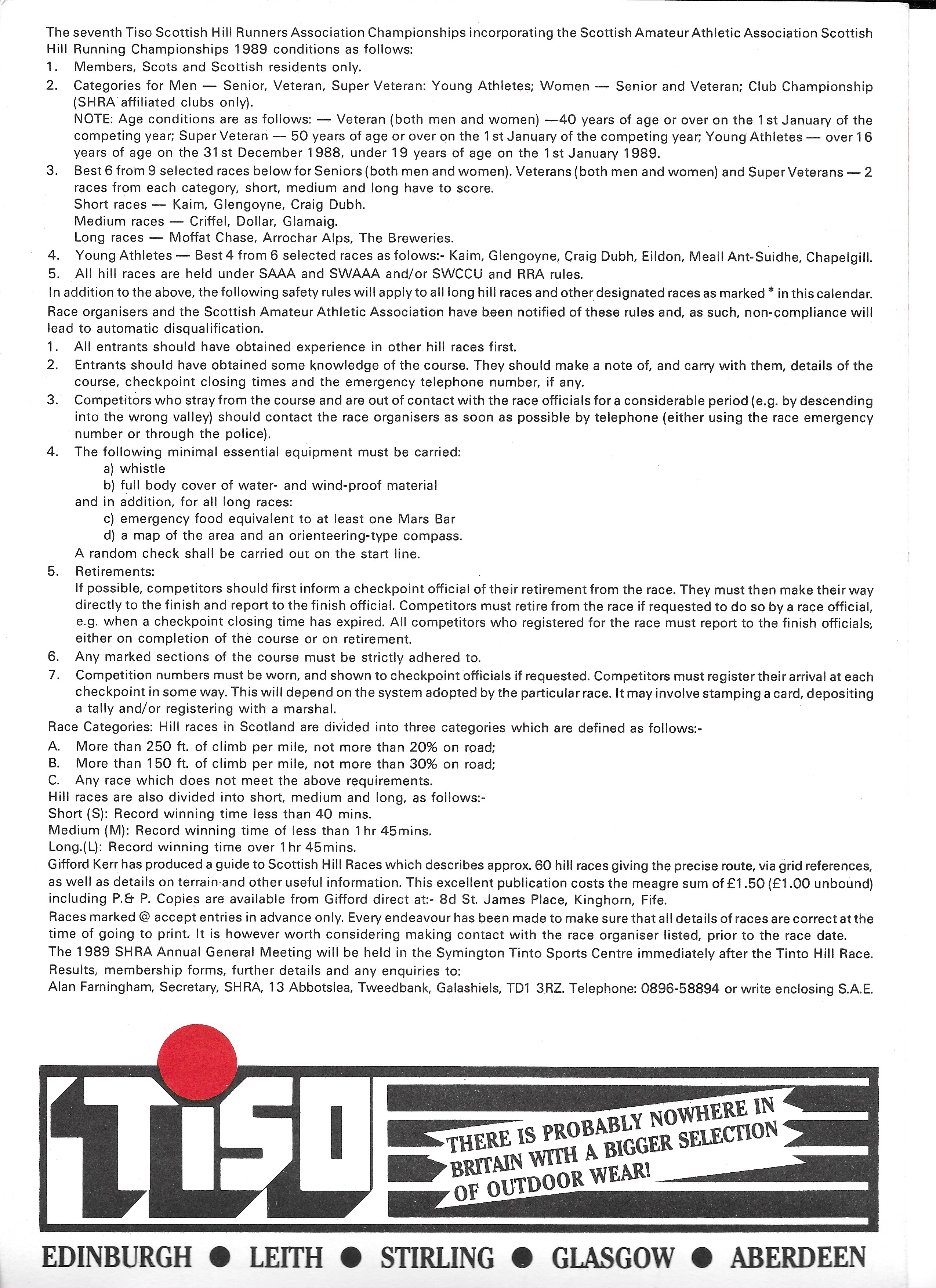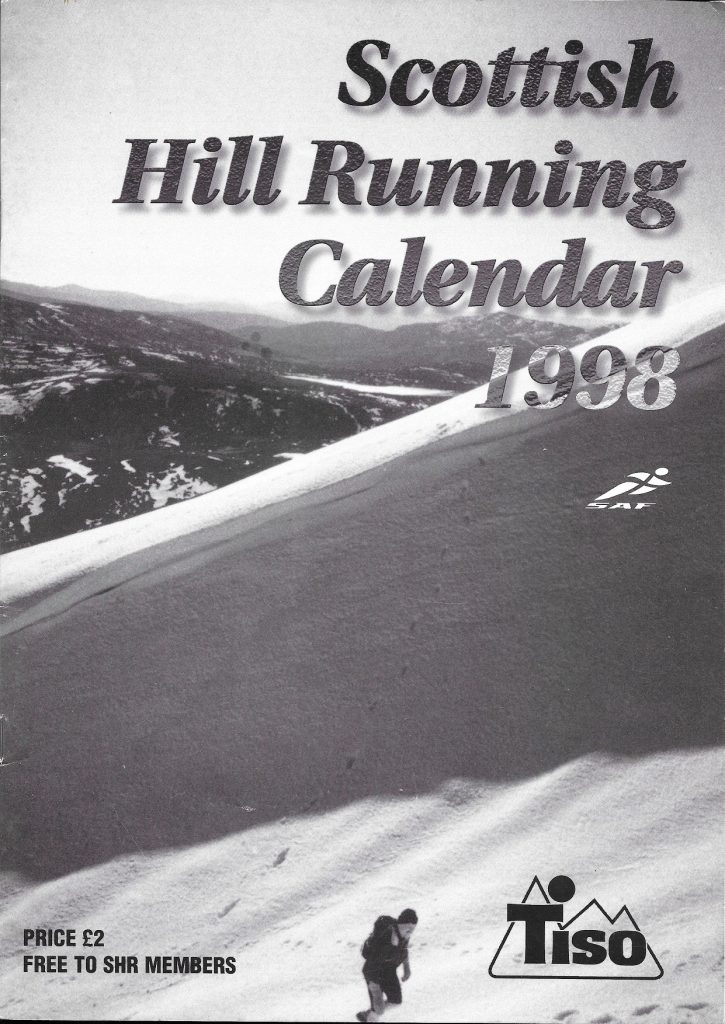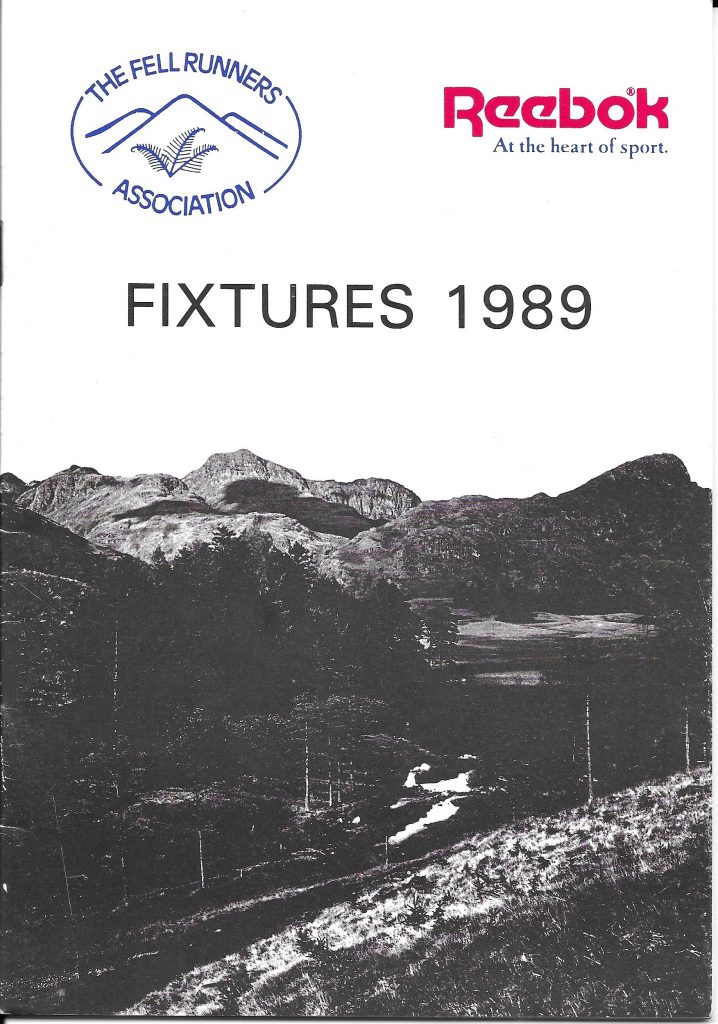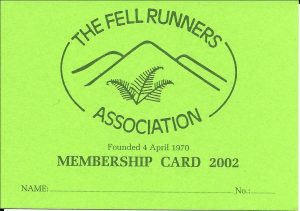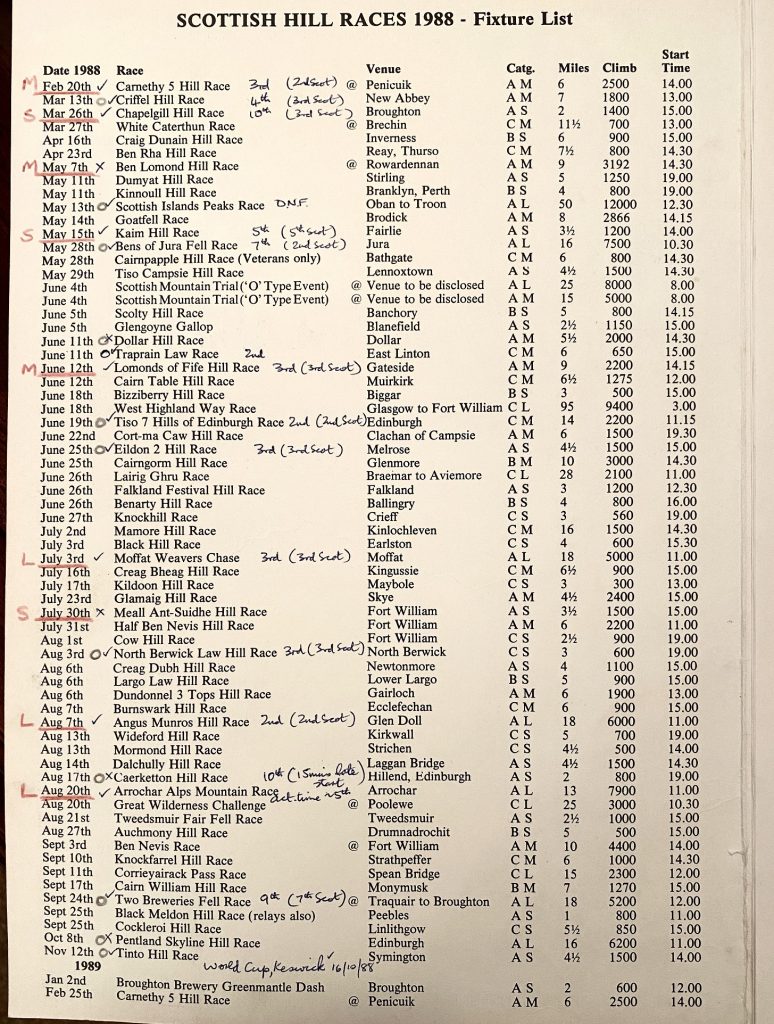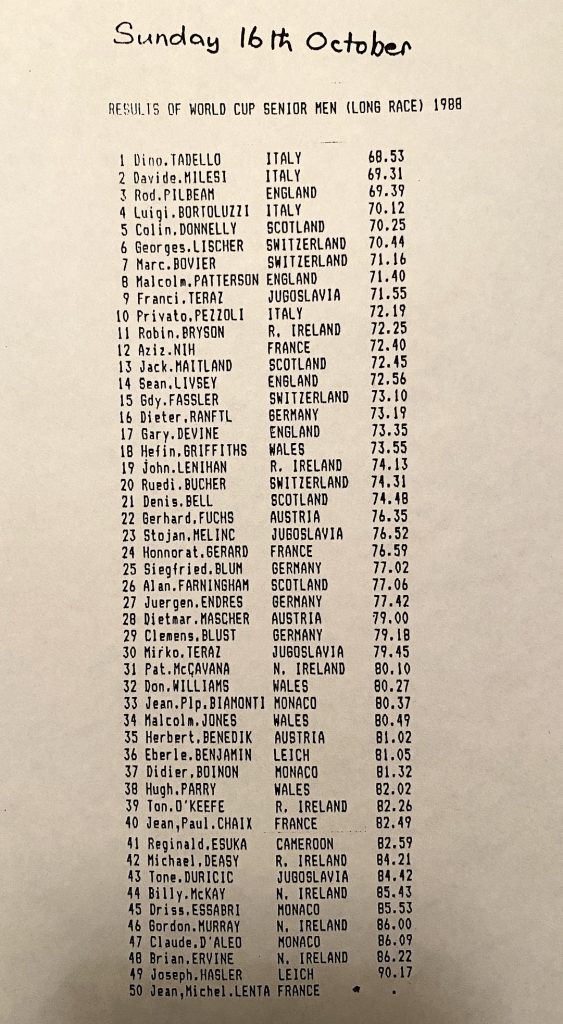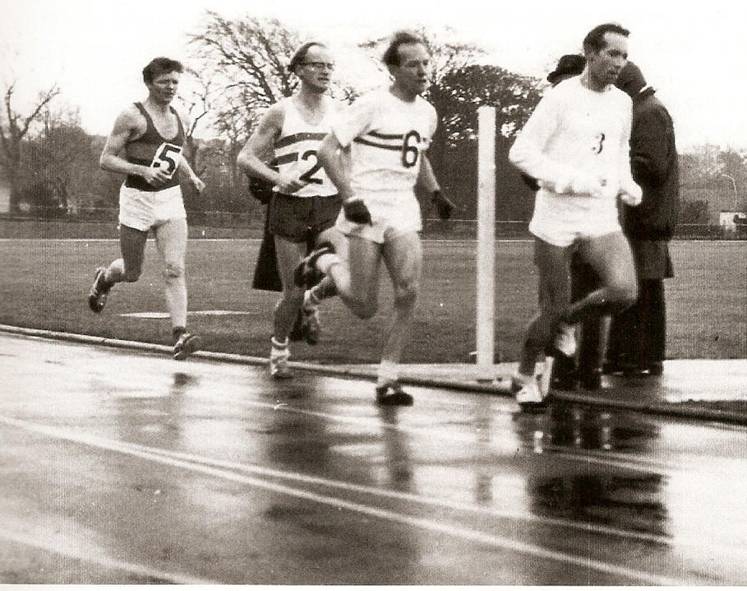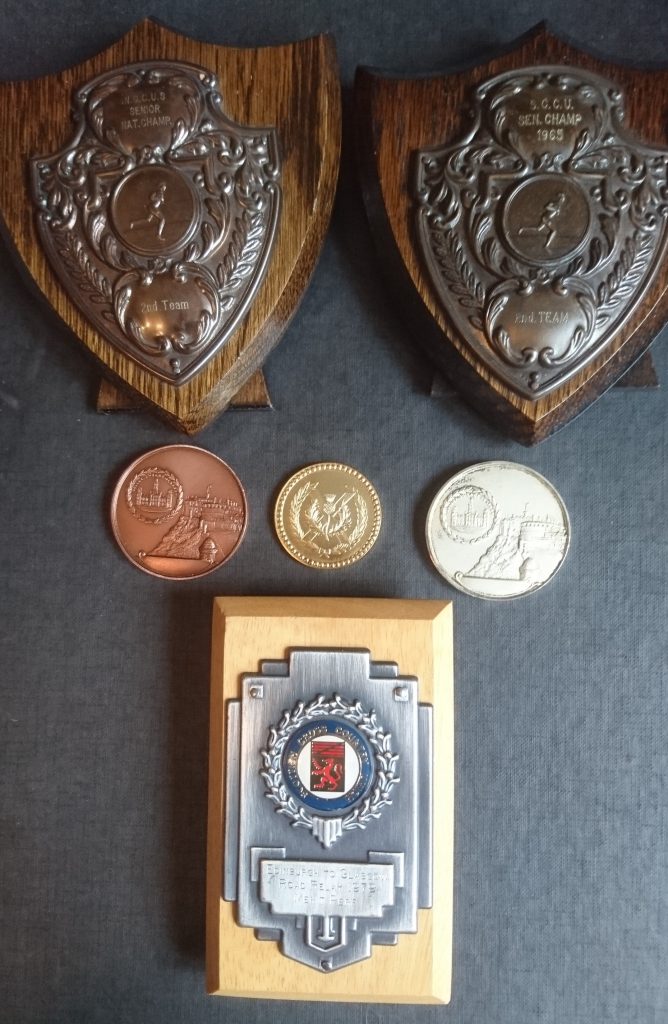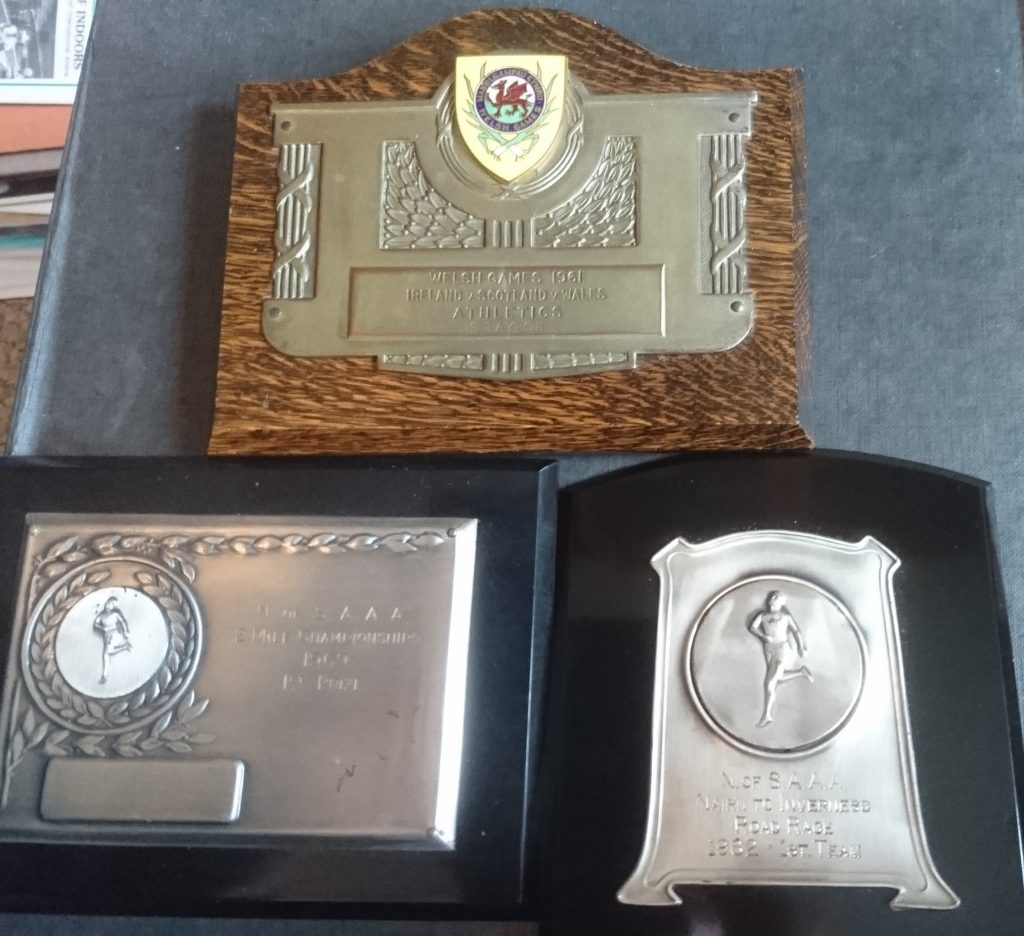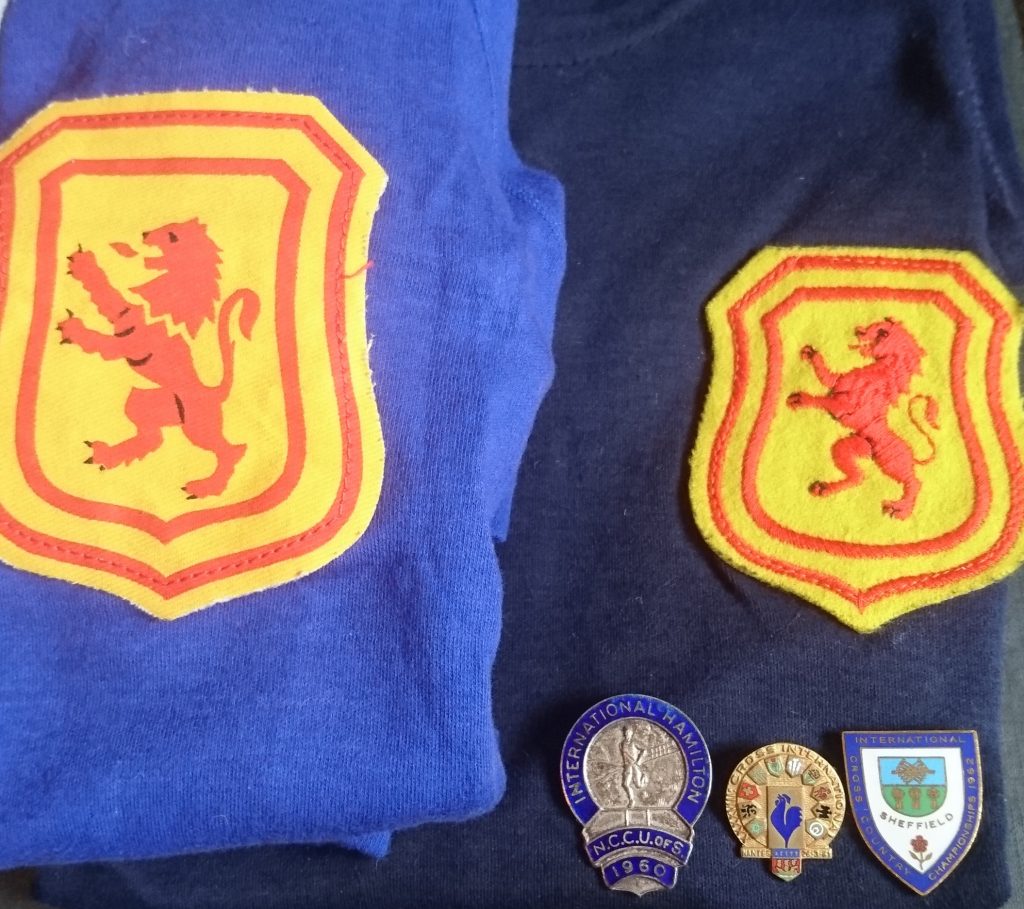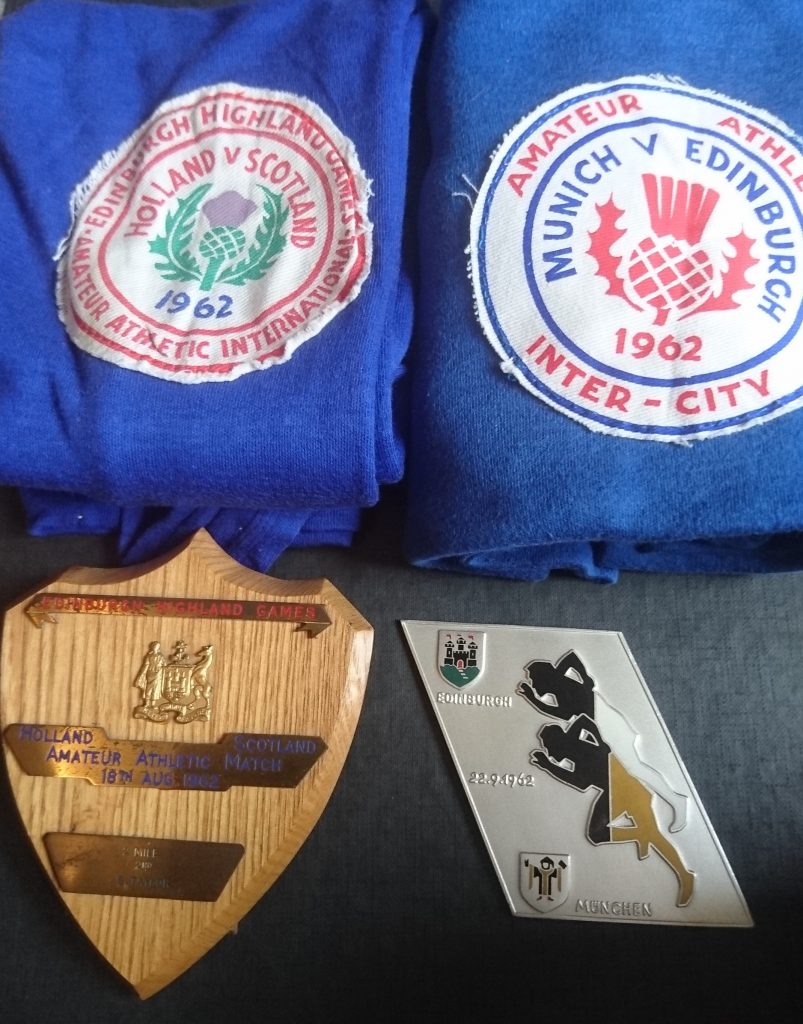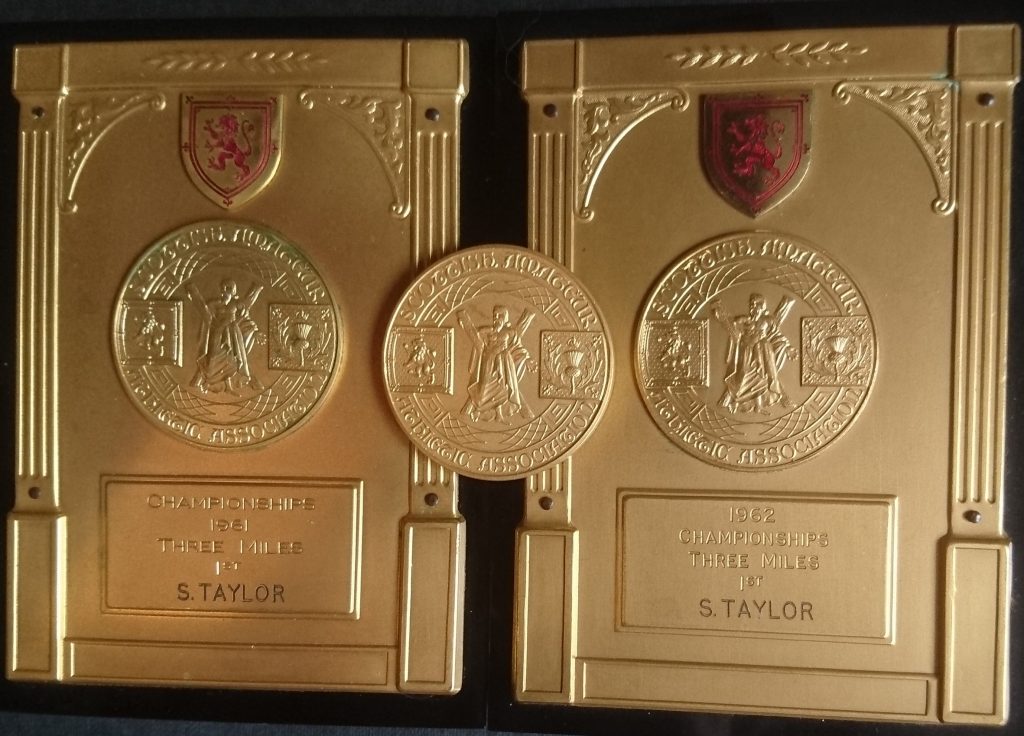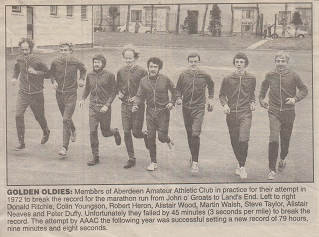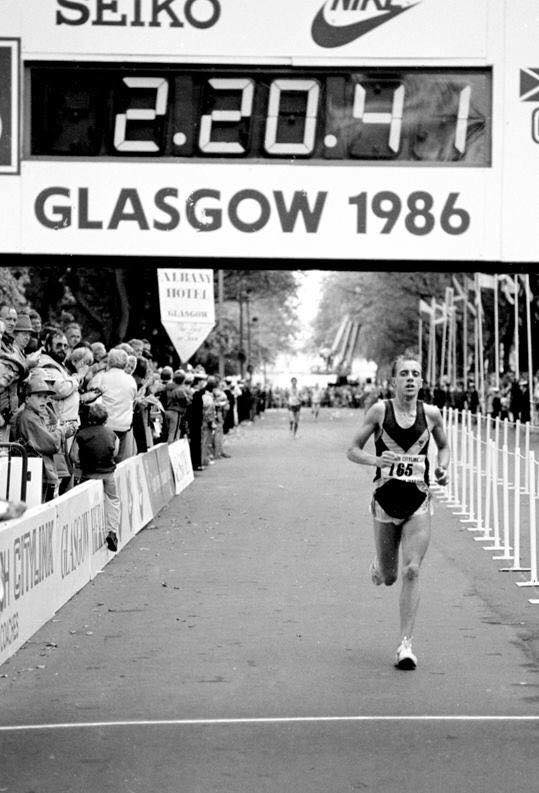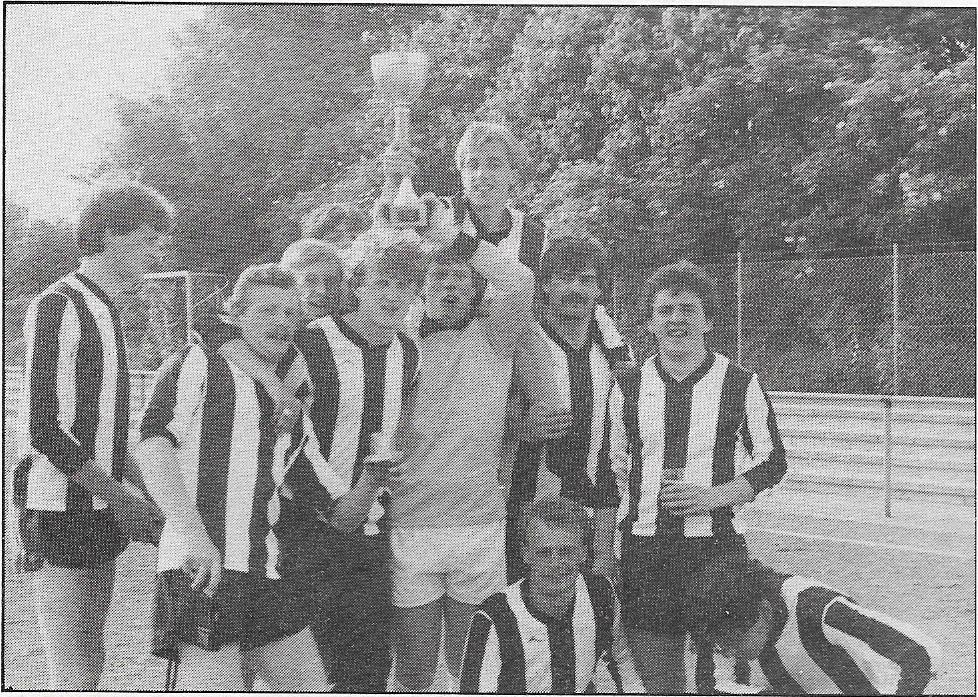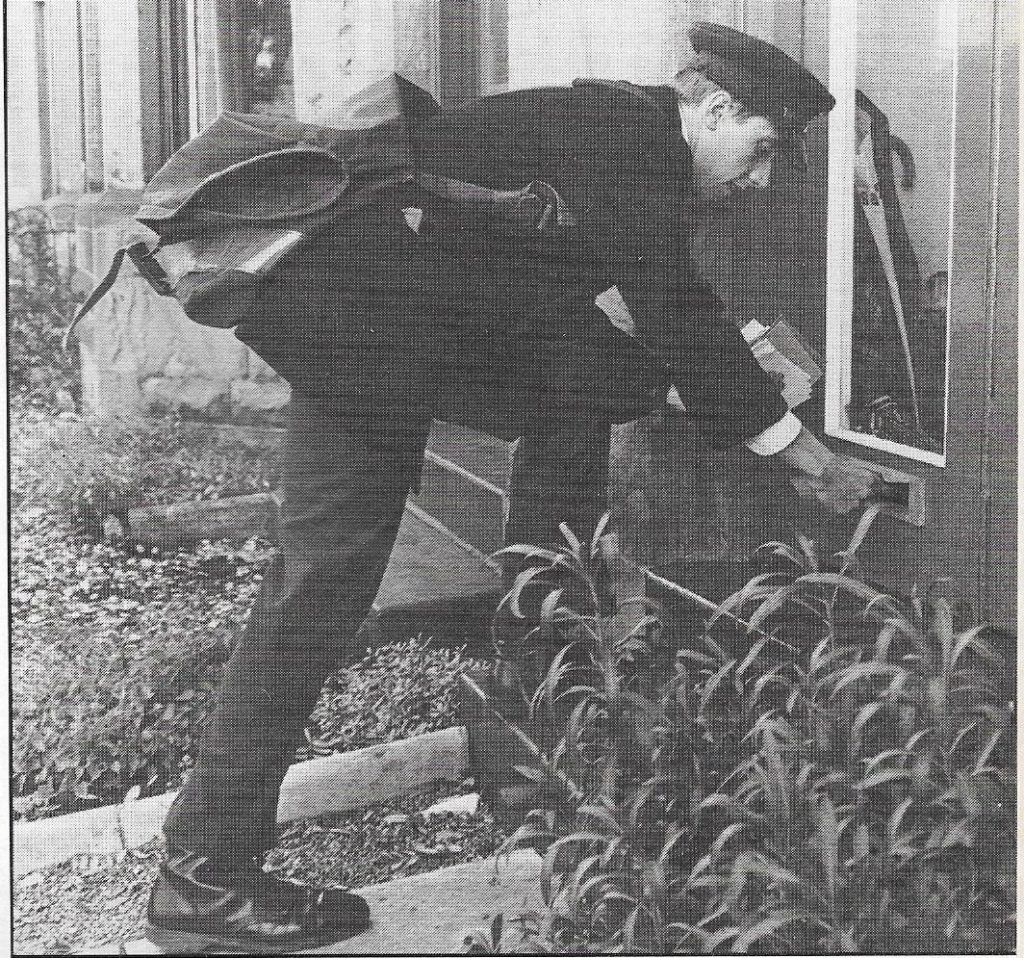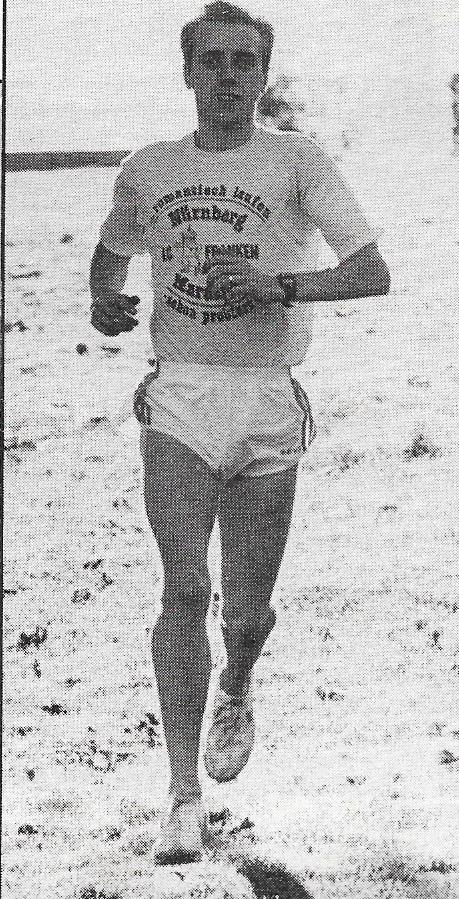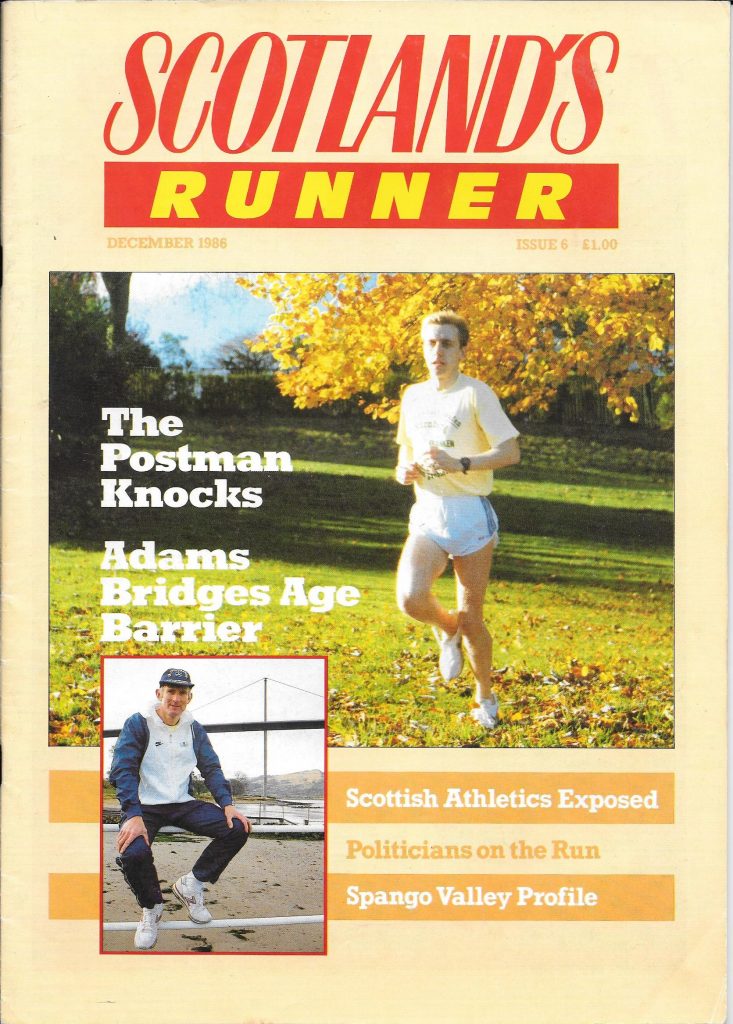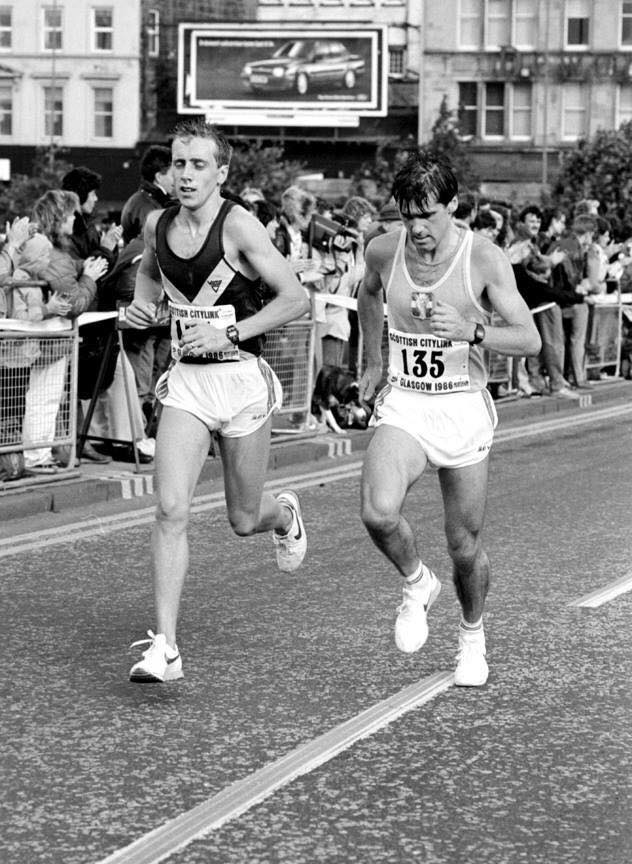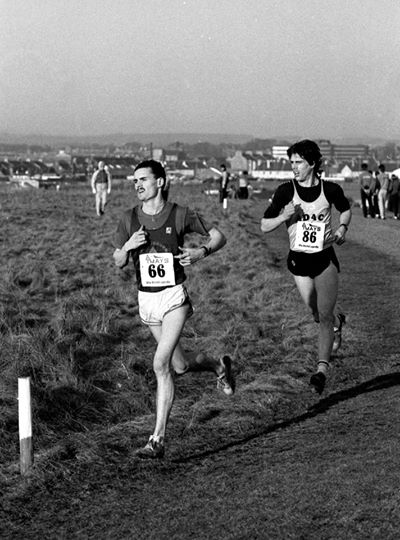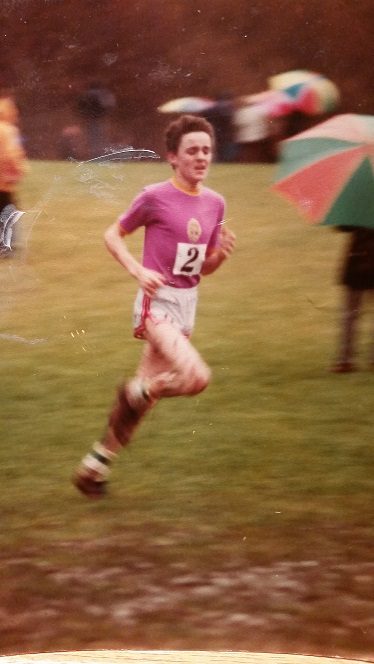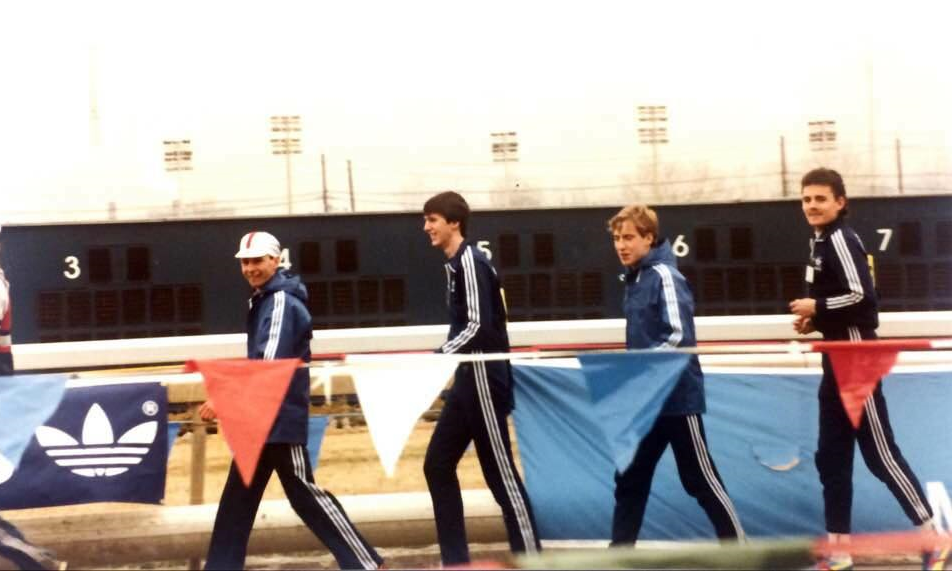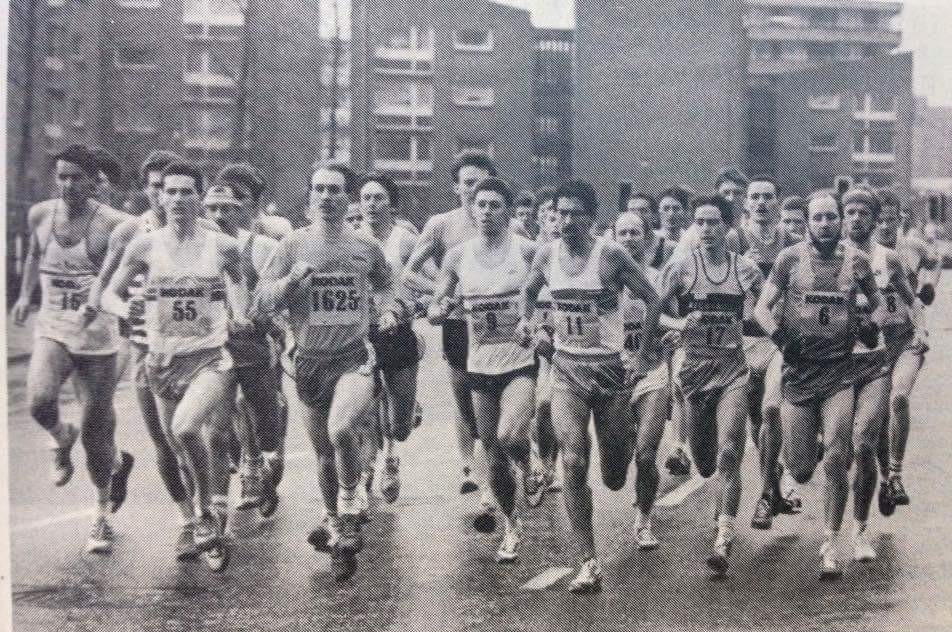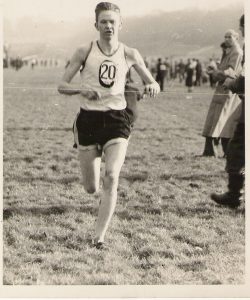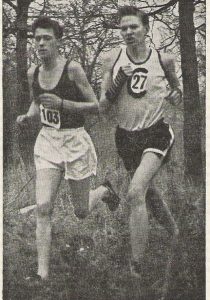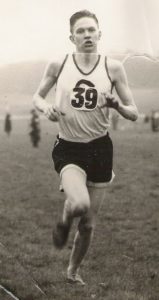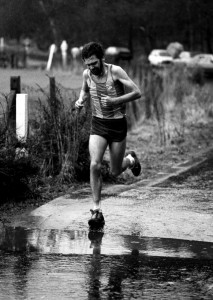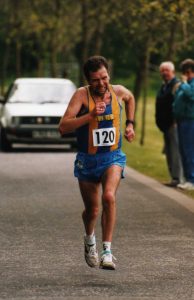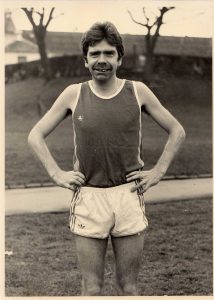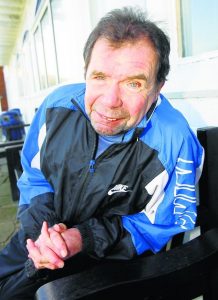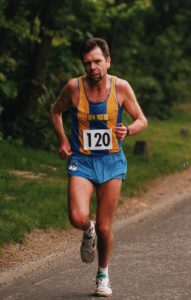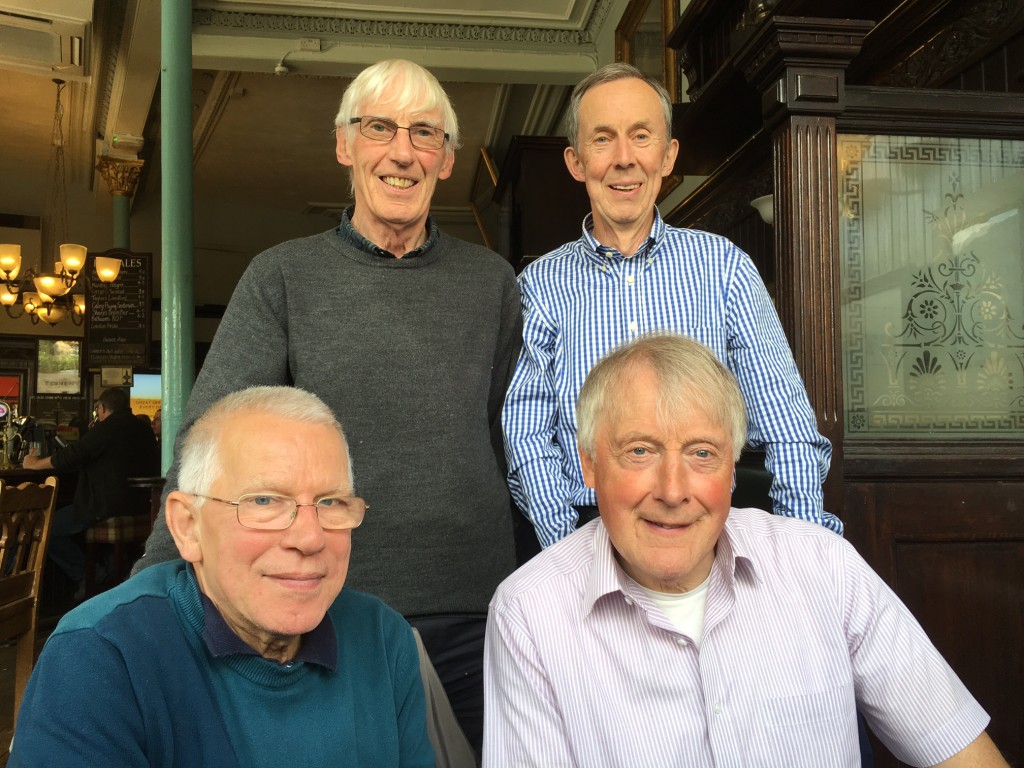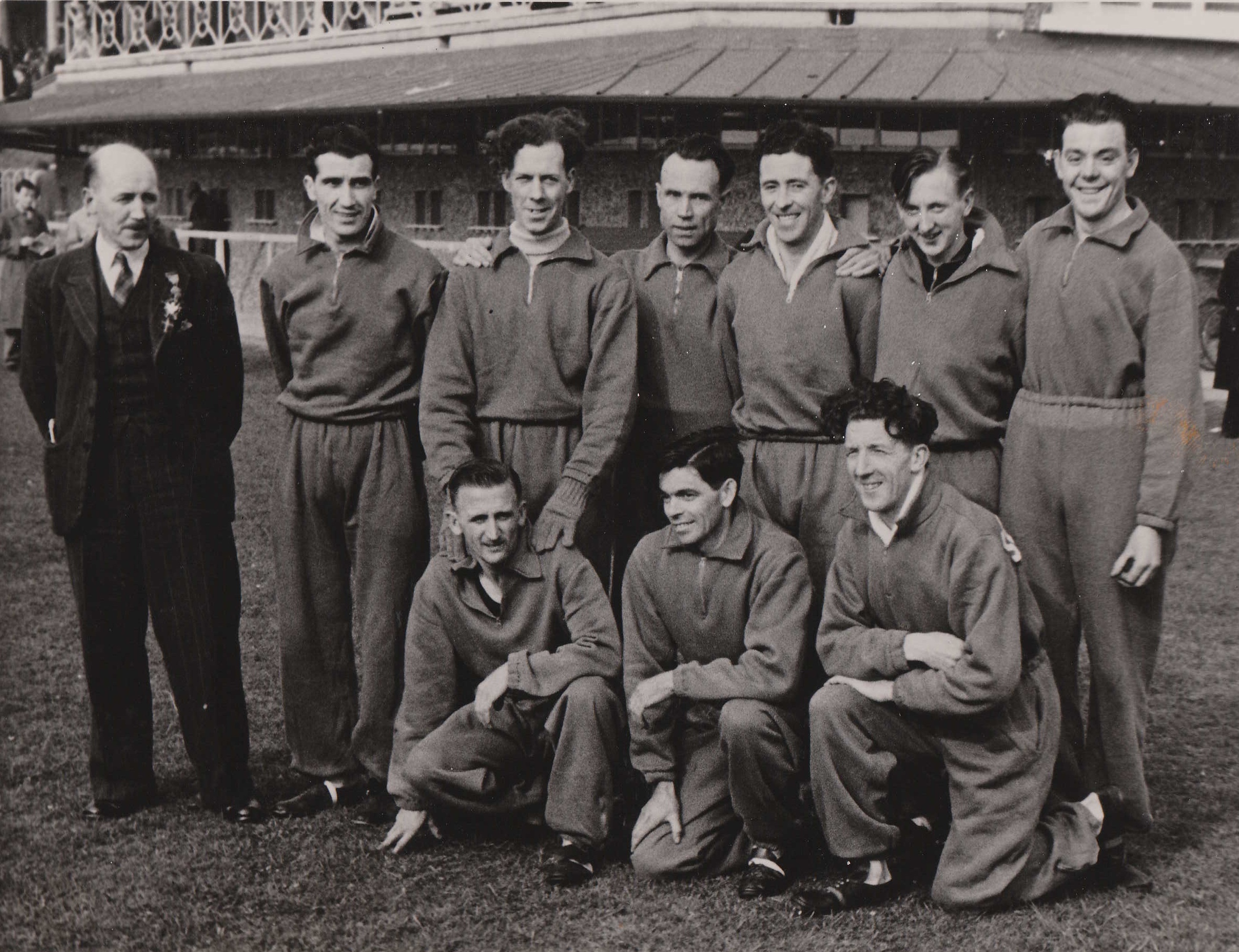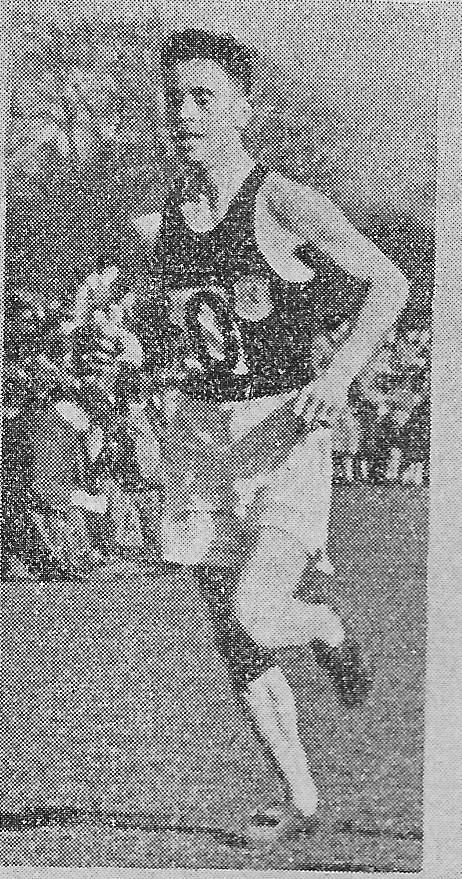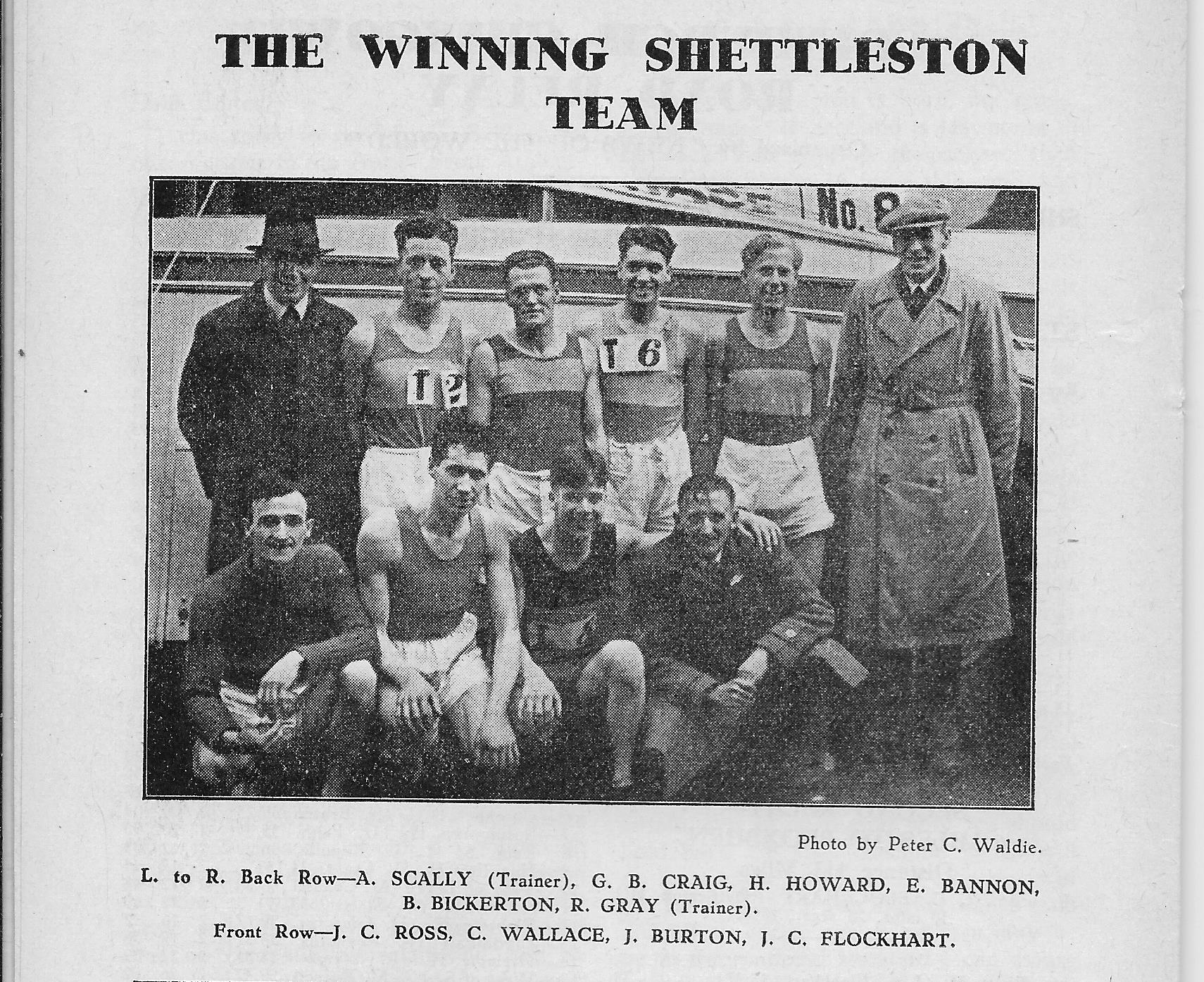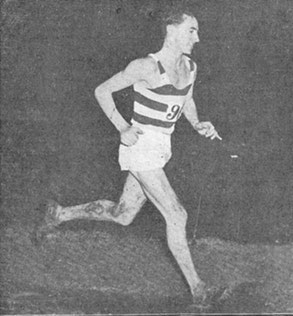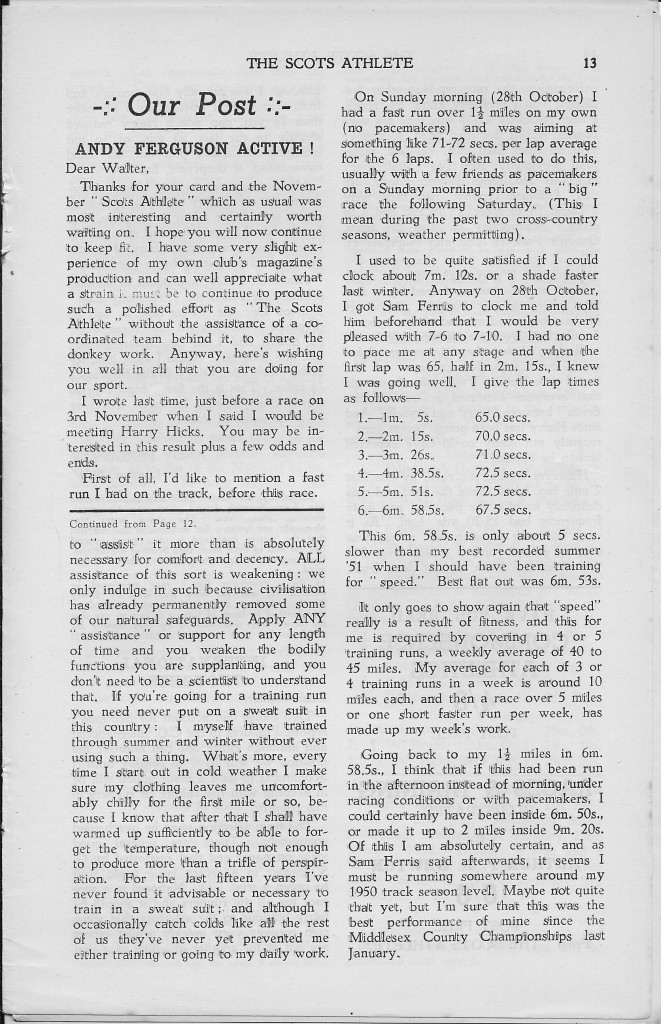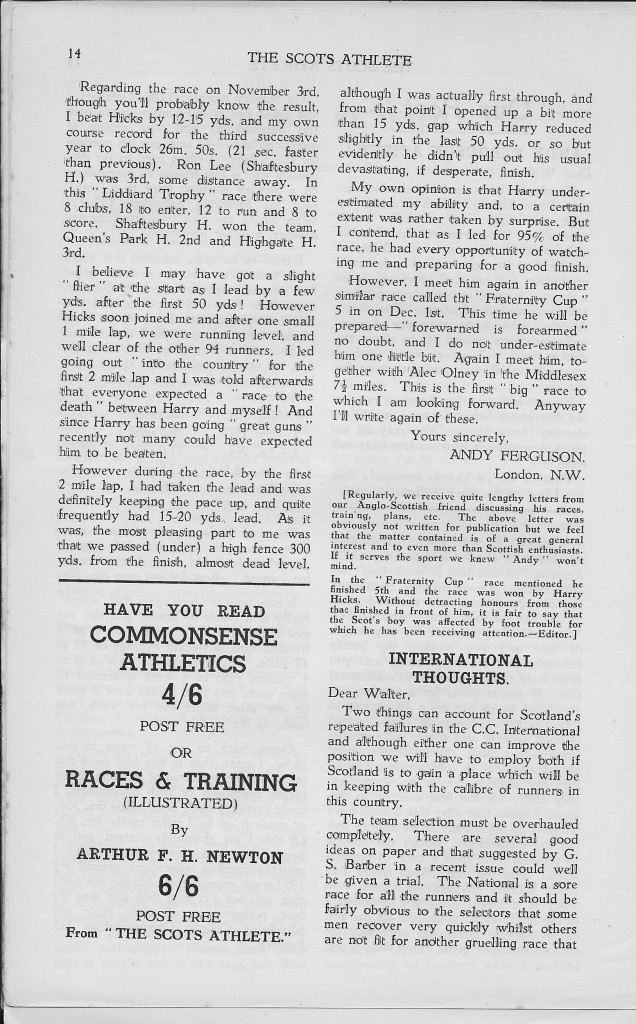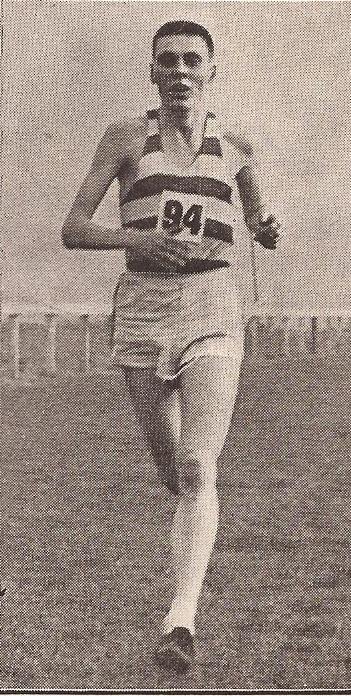There are races all year round for hill runners. When we hear or think of running in the hills what springs to mind are athletes running on green, grassy hills in spring and summer but hills are run in winter too – look at Denis on Carnethy in the snow – and even in spring and summer Scottish weather can produce rain, hail and showers. Even in summer the sun can be so hot that it burns the skin and dehydration is a serious problem. That’s not all the time but these are all eminently possible whenever the race takes place. And if you’re prone to sea sickness, don’t tackle the Island Peaks Race. The skills required to be a successful or even competent hill runner are many. How does a hill runner’s year look? Does it aim for a single peak race, or does it look for a plateau of races through the summer? Do the runners specialise in short, medium or long distance races? Some do but if they want to head for the Championships, then all three types of race have to be tackled. Of course it is always, for even experienced hill racers to lose the trail at some point, and some races require that the runners carry a map and/or compass. This means knowing how to use them as well as carry them. The best way to find out what it is like is to ask a hill runner. With that in mind we asked Denis Bell what the hill runner’s year looked like, and how he went about preparing for it. This what he told us.
Category: Elite Endurance
STEVE TAYLOR’S TROPHIES AND MEDALS
Steve Taylor (6) and Alastair Wood (2)
There are some athletes whose name and reputation precedes them wherever they go and there are others who are known simply by their first name such as Lachie and Fergus. Steve Taylor was never known or given credit for the running that he did over many years and on all surfaces. An excellent athlete he ran well on the road, over the country and on the track; he ran well as an individual and as a team member. We already have a profile of his career at the link below [click on his name] but Colin Youngson has put together this page of trophies and awards that he won over the years. There are medals, plaques [individual and team], and vests. Every one was well earned and well deserved. Spend some time reading what they were for – the range will maybe surprise you. Colin has this to say.
Stephen Taylor – (1938-2019) – (widely known as Steve and very fondly as Stevie) was an Aberdeen AAC running legend. He was Alastair Wood’s most important training partner and friend and enjoyed a long and successful athletics career. He represented Scotland three times in the International Cross-Country Championships (1960 at Hamilton Racecourse; 1961 Nantes; 1962 Sheffield); and five times on the track. As well as being a very talented elegant runner, he had considerable success over distances ranging from one mile to thirty. In addition, he was fantastically strong in training and an encouraging captain who truly led by example when his beloved distance-running club proved to everyone that it was one of Britain’s very best – by breaking the record in 1973 for the 850 miles John o’ Groats to Land’s End ten-man Relay.
His trophies and medals included the following:
National Cross Country Union of Scotland East District Youths Race team
RAF Signals Command Cross Country first team
RAF Signals Command track silver medals for 880 yards and One Mile
NCCUS East District Relay second team
NCCUS Senior National Championships second team
ICCU badges for three successive runs for Scotland
Scottish Cross Country Union Senior National Championship second team
SCCU East District Championships 1967 first team
SCCU Edinburgh to Glasgow Road Relay ‘Most Meritorious’ plaque 1979
Silver and Bronze team medals in the E to G
North of Scotland AAA Nairn to Inverness Relay first team
N of SAAA 2 Mile Champion 1969
1961 Welsh Games Scotland v Ireland v Wales Track International (2 Miles)
Track International Plaque for Edinburgh Highland Games Scotland v Holland
Medal for Munich v Edinburgh track ‘international’ in Germany
Scottish Amateur Athletic Association 3 Miles Champion plaques 1961 and 1962
SAAA 10 Miles Track Champion medal 1970
SAAA silver medals for One Mile (1960); 3 Miles (1965 and 1966); and bronze for 6 Miles 1964.
Winner of the 1971 Shettleston Marathon; and the Elgin Highland Games Road Race
1961 Morpeth to Newcastle Road Race fourth place plaque
1968 North Inch Relays first team
1973 plaque from West Penwith RDC to recognise AAAC breaking the JOGLE record
1976 Lairig Ghru race plaque
1976 Scottish Universities Road Relay first team
That is quite a collection: none of the above were for simply finishing a race. Colin, no mean runner in his own right, and Steve were very good friends and I thank him for putting it together.
Billy Robertson
Photograph by Graham MacIndoe
Billy Robertson’s time as a member of Bellahouston Harriers slightly over lapped with the great squad of Braidwood, Coyne, Daly, Fleming, Getty, and company and it is a tribute to his running and determination that he is able to be ranked alongside these superb runners. Billy (Date of Birth 16th April, 1957) came late to the sport and arrived arrived suddenly without warning, as a top flight distance runner. Unlike all of those mentioned above, he had no career in the sport before 1985: he had never run as a Junior, Youth or even Senior Boy. Where did he come from? The picture gives a wee hint.
Photo by Russell Aitken for Scotland’s Runner, December, 1986
Alan Campbell told the story for ‘Scotland’s Runner’magazine as follows. “His sporting passion was football at which he played sweeper for East Kilbride Sunday League side Newlandsfield Amateurs. While a competent player, he was unlikely ever to press Willie Miller or Alan Hansen for a place in the Scottish team. The 1985 Glasgow Marathon was only four weeks away and his wife Diane kept asking, “Are you doing this Marathon or not?” Billy decided he would put in a 13 mile training run two weeks before the big day and ended up with a time of 3:52. That was when Billy decided he might be better at running than football. Incredibly twelve months later, Robertson was seventh in the Glasgow Marathon in 2:20:42.” And that is the story of the two photographs above: Billy holding the trophy for the football team, and about to cross the finishing line in the 1986 Marathon.
Billy confesses later in the same article in the December, 1986, issue of the magazine that he had actually tackled a marathon before 1985. “I was quite fit, playing football on Sundays and training for it one night a week. The plan was for the football team to enter the marathon that year but they never got around to it. I still wanted to do it. Just for the achievement. It was supposed to be so tough. I trained for about 10 weeks going out on long runs although I built up slowly. The longest run I did was 20 miles at about eight minute a mile pace. … The race was an anti climax. I had heard so much about hitting the wall but I found the whole run quite comfortable.” His time on that outing was 3:16.
He had thought of joining East Kilbride AAC but a couple of his colleagues ran for Bellahouston Harriers and that is where he ended up. The postman was now a club runner with a 2:20 marathon behind him.
The Day Job
At the start of season 1985 – 86 Billy was a member of a really successful athletic club, it was October and he would learn that the season started with the relays. At the start of the month he went down to the club to find himself in the trial for the McAndrew Relay Race at Scotstoun. It was a hard race – and with the top clubs the trial was often as hard as the race itself – and he was a bit down afterwards. He had never raced as hard over any short distance and convinced himself that he had only joined up for training purposes, not to race. He didn’t run in the McAndrew but the following week he was persuaded to turn out in the Renfrewshire Cross-Country Championships. He ran in the seventh club team that day and found that he really enjoyed it, despite the rain and the cold. By the National Cross-Country Relays on 26th October he was running for the first team (in the absence of Fleming, Daly and Braidwood) and acquitted himself honourably. He then raced the following day in the Alloa Half Marathon, he’d never raced one of those before, and finished 4oth in 1:14. It was at this point that he decided to stop the football – he liked running more than the ball game by that time and there was always the injury risk attached to it too. He couldn’t do both, so the football was dropped.
By now he was training with Andy Daly and the others on a Sunday for the long run and on Tuesday and Thursday at the club. He was also going to Crown Point track on Wednesdays to train with Peter McGregor’s group and, being a postman finishing at mid-day, he was able to rain in the afternoon on Monday and Friday. But back in the racing world he was still a new boy, despite his ability, and did not makethe strong Bellahouston team for the Edinburgh to Glasgow eight stage relay, the places going to such as Fitzsimons, Daly, Braidwood, Fleming, Getty, Coyne and Adair. Injuring his heel in the Pollok 10K in January he was out of action for 10 weeks. Unlike many runners with an injury, he didn’t attempt to ‘run it off’ instead he had treatment and massage from Ricky McFarlane, former St Mirren manager and there were regular visits to the Eastwood Toll Swimming Baths. At the start of the track season he ran the Clydebank Half Marathon in 71:40 and then tackled another at the same distance in Stirling. Here he came through 10 miles, running alongside Hammy Cox, in 51:15 compared to his existing 10 miles pb of 56:35. His finishing time for the Stirling Half Marathon was 67:47 for ninth place. This was the race that convinced him that he could run with the best of them. There were lots of half marathon on the calendar at that time and he turned out in the Glasgow Half Marathon in August. He ran awayfrom the field with training companion Andy Daly and they finished together in 66:48. The judges, always keen to have a declared winner, gave the verdict to Billy. Andy agreed that Billy should take the prize of a flight to any destination in Europe! But two days after the half marathon, Billy won the Renfrewshire Track 10000m in 30:45. The next big one was the Glasgow Marathon of 1986 – his first as a serious runner. Running with the lead pack he was quite comfortable through 10 miles in 53 minutes but when Kenny Stuart made a break at 11 miles he didn’t know quite what to do – it was the first time he’d raced a marathon. He let them go and had several bad experiences – a bad patch at 12 miles, stomach cramp on the Barrhead Road – but finished seventh, first Glasgow man home and a time of 2:20:42. The place earned him a trip to the Nurnburg Marathon, the city being twinned with Glasgow. He was a bit anxious about racing two marathons so close together but he finished second over the four lap course in 2:26:16. 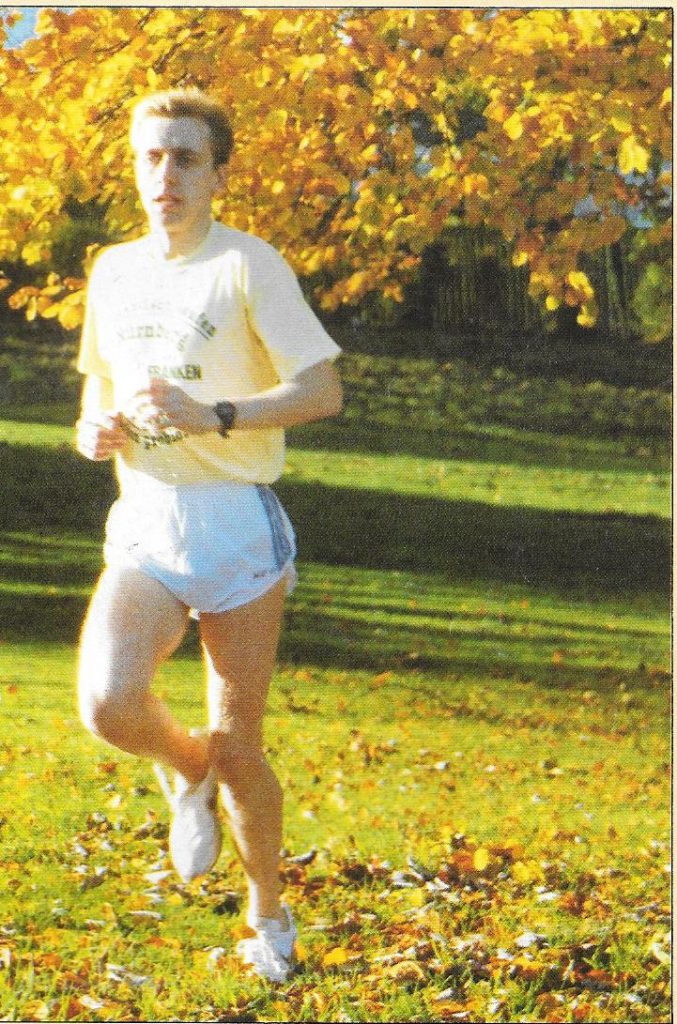
It is a reflection the standards at the time that his 10000, time of 30:45.0 only placed him 20th Scot in the annual ranking lists and even more astonishing that 2:20 for the marathon only placed him 14th. His first season as a runner had been a success and all runners are interested in what others do in training. The ‘Scotland’s Runner’ magazine gave us a typical week’s training at the end of 1986 for Billy Robertson.
Monday: Long Run (18-20 miles) at 6 minute mile pace.
Tuesday: Sri Chinmoy 2 mile race on Glasgow Green.
Wednesday: Interval Training: 20 x 200 (31 sec with 45 secs recovery); or 8 x 300 (45 secs with 60 secs); or 10 x 400 (65 secs with 90 secs)
Thursday: Ten mile club run at 5:40 pace.
Friday: Five miles, easy pace.
Saturday: Off if racing on Sunday
Sunday: Race.
Winter 1986/87 he was introducing hill training on a Monday, and more quantity interval training at Crown Point Road on a Wednesday. He said “I think I get away with such a low mileage by being a postman. I must walk about 50 miles a week, and also cycle about 30 miles between my house and work, and my house and the club.”
By October 1986/87 he knew about the relays leading up to the Edinburgh to Glasgow on the third Sunday in November. He was ready for the McAndrew and ran the first stage for the Bellahouston team which contained Peter Fleming, Robert Fitzsimons and Tony Coyne and finished third. He was second quickest member of that quartet and was asked to run the first stage of the Renfrewshire Relays the following week at Linwood. This time the team included C Thomson, Daly and Coyne. Again the team was third and he had third fastest club time, one second slower than Daly. He missed the West District relays in Clydebank and the National relays on the last Saturday in the month, the twenty fifth. Why did he miss those races? The Nurnburg Marathon was on the 26th October where he was second to Przybyla (Poland) and Allan Adams, Senior, from Dumbarton was fourth in 2:29:07.
Billy was ready for the Edinburgh to Glasgow this year and on 16th November he ran on the very difficult second stage where he moved his club from 16th to 13th for the team that finished 10th. It was a good solid run against the top men. The New Year started for Billy with the Springburn Cup raceat Bishopbriggs on 10th January when he was eighth, one place behind George Braidwood for the team that won the event. On the 18th of the month he ran in the Pollok Park 10000m race and finished fourth behind Peter Fleming, Graham Crawford and Bill Scally and just ahead of Andy Daly, John Hendry and R Guthrie. With their counting runners placed 1, 4 and 5, Bellahouston won the team race from Bellahouston B team with runners 6, 7 and 16 with Maryhill third and Kilbarchan fourth. Two weeks later, on 28th January, at Riccarton in Edinburgh he was second in the Civil Service Championships, one place behind Bill Nelson and one ahead of Andy Daly. On the 31st January he was sixth in the prestigious Flockhart Memorial Race at Coatbridge.
On 7th February, with the championship season starting to reach its climax, he ran in the Renfrewshire County Championships and finished second to Peter Fleming and again Bellahouston won, this time by 64 points from Spango Valley AC. In the West District Championships at Kirkintilloch, Billy finished 16th to be fourth Bellahouston runner in the squad that finished second, 20 points behind Spango Valley. The National Championships were held on 28th February, 1987, at Falkirk and Bellahouston Harriers was second team, behind Edinburgh Southern, with Billy fourth club counter in 27th place. The last championship of the year was on the 28th March and it was the Six Stage Road Relay. Billy was on the 3rd stage He pulled the team up from 8th to 4th and was the fastest club runner on the short stage. It was then on to the summer season.
Into the summer of 1987 and Billy ran in the Civil Service 10 miles in Strathclyde Park on 15th April where he was second to Andy Daly in 51:49. Although he was almost certainly running frequently there were very few 1st, 2nd or 3rd places noted in the results columns of Scotland’s Runner or the Glasgow Herald. There was a 10K Road Race in Govan on 6th June when 277 runners competed, Billy was second to Frank Harper of Pitreavie in 31:31. He followed this with second in the Clydebank Half Marathon on 14th June where he was beaten into second place by Alex Gilmour but recorded a time of 67:48. On 16th August he ran in the British Airways Glasgow Half Marathon and was second to clubmate Peter Fleming in 66:13.
The Glasgow Marathon in 1987 was run on 20th September and Billy was in there competing. Statistics tell us that there were 8500 entrants (the previous year there had been 14,200), 25 finishers under 2:30 (previous year 33), and 500th place was home in 3:02:32 (the previous year it was 2:5758). Billy finished eighth in 2:22:13 and won £100 for that. The race was won by Eamon Tierney of Clonliffe in 2:19:09 from Terry Mitchell (2:19:40), Hammy Cox (2:19:43) and Greg Newmans of Cardiff (2:19:55). Billy’s time was good enough to see him ranked 15th in Scotland at the end of the year although it would have seen him third Scot in 2018. He was also ranked 8th in the 10000m with 30:07.9, would have been 7th in 2018.
October 1987 started the winter relay season with a win for Spango Valley at the McAndrew Relay on 3rd October but Bellahouston finished third to start among the prizes. The following Saturday it was the Renfrewshire County Championship where the Bellahouston team of Daly (12:39), McAngus (12:25), Thomson (13:20) and Robertson (12:28) won from Spango Valley. The West District Relays were at Strathclyde Park and Bellahouston’s squad of Coyne, McAngus, Robertson and Fitzsimmons was fourth team – Billy Robertson was sixth fastest individual on the day. Fitzsimmons and Robertson were switched the following week for the National Relays at Annan although the team personnel remained unchanged. They were fifth this time. Billy skipped the Glasgow University Road Race and on 15th November he ran in the Edinburgh to Glasgow relay. By common agreement the two toughest stages in a race without any easy stages are the second (the stage of champions) and the sixth (at 7 miles the longest in the race). Billy was out on the sixth stage where he took over in 11th place and picked up one place and a lot of ground to hand over in 1oth for the team that finished seventh. At the end of the month (28th) he was running for the club in the County Championships at Greenock where he was second to Tommy Murray for the team that finished second behind Spango Valley.
He started December with a run for the SCCU in an international cross-country match at St Andrews, finishing seventh: the team won. The next championships were the West Districts – held at Houston in Renfrewshire on 16th January 1988 – in which the Bellahouston team finished second to Cambuslang. Then came the big one on 22nd February when the National Championships were held at Beach Park, Irvine, and Billy had a good run to finish 15th for the team that was missing a few of the top men and finished 14th. In March he had another representative call-up and ran in the Cumbernauld Inter-Area Match where he was second to Eddie Stewart on the tough undulating and in places very muddy course. The final club championship of the season was the Six Stage Road Relay at Livingstone on 26th March where the team won third place medals and Billy ran on the final long stage of the race. There were no weak links this time – Fitzsimmons, Daly, McAngus, Fleming, Coyne and Robertson made up the team. The runner for the winning Springburn team was a former Bellahouston hot-shot who had moved to Springburn and joined the local club: none other than George Braidwood who kept them in the lead although Billy had the satisfaction of running a time of 29:32 to his rival’s 29:51. It was then into summer racing mode on the firmer surfaces of tar and tartan.
On 13th April Billy won the Civil Service 10 Mile road race at Strathclyde Park in 49:45 from Tom Ulliott and Mark Gormley (both of Cambuslang Harriers). Other than that he was hard to spot in summer 1988. He did compete on the track however with best times of a 5000m in 14.25.2 to be ranked 9th;and a 10000m in 29.56.12 to be 5th ranked Scot. This latter was achieved in the SAAA Championships on 22nd July at Crown Point – the first time the championships had been held in Glasgow since the early 1950’s. The report in “Scotland’s Runner” read: “This race, the last final on Friday evening, proved to be one of the classic tussles of the championship. A group of six – Peter Fox, Tommy Murray, Billy Robertson, Alastair Douglas, Alex Gilmour and Alan Robson – broke clear of the large field at about 3000m, this group whittling down to Murray, Douglas and Robertson 600m later. Robertson was dropped just after halfway, and it then became a battle of attrition between Murray and Douglas, the little Glenpark Harrier knowing that somehow he had to burn off Douglas before the end. For the last eleven laps (70 sec, 69, 71, 71, 72, 71, 72, 71, 72, 70, 64) they clung together before, with 100m remaining, the inevitable happened and Douglas overtook to win in 29:29.40 – almost his exact time in winning the Inverness 10K over the roads just five days previously.”
- A Douglas (Victoria Park) 29:29.40; 2. T Murray (Greenock Glenpark Harriers) 29:31.43; 3. W Robertson (Bellahouston) 29:56.12; 4. P Fox (Motherwell) 30:00.10
Billy was less than half a minute behind the winner in a hard fought race. This would be the only SAAA track championship medal he would get – but remember that he was running at a time which might well be regarded as a golden age of Scottish distance running.
The 1988/89 winter did not start well for Billy who missed all the relays – a man who had run in every relay for the club over the previous years was absent even in the National Relays when the club had no fewer than six four man teams finishing the race. He even missed the Edinburgh to Glasgow eight man event where he had performed well on the difficult stages in the past. Into the New Year of 1989 and while he was listed on the programme for the West District championships at Kilmarnock, he did not start the race. Then on 4th February 1989, Billy ran in the Cumnock open cross-country race and finished third in very good company. Nat Muir won on a very muddy course in 34:33 from Steve Ovett who was timed in 36:52 and Billy in 37:22. Clearly whatever had been troubling him – he had not even urn in the Civil Service races – had cleared up. He then ran in a midweek Civil Services Winter League match on 22nd February and finished second to Bill Nelson. Further proof of his return to form came in the National Cross-Country Championships at Hawick on 25th February 1989 when he finished 34th out of a total of 546 finishers and first Bellahouston runner for the team that finished eleventh.
He was back on the roads again when he ran in the Clydesdale Harriers 5.5 miles Road Race on 11th March, finishing sixth in a good field. It was back to the track on 16th February in the Civil Service Track Championships when Billy turned out in the 3000m where he was third in 8:42.0 behind Robert Fitzsimmons who had a glory day (he won both 800m and 1500m as well) and Bill Nelson. Back on to the roads and up a distance or three for the Civil Service 12 miles on 12th April: first this time in 52:48 from Mark Gormley and Jim Evans. At the end of April (30th) Billy turned out in the Kodak 10K Road Race in Glasgow (always a high quality field) and finished 14th ahead of Nat Muir, Chris Hall, Doug Frame and Brian Emmerson in 30:06. He followed that very quickly with a fourth place in the Adidas Torsion 8K also in Glasgow on 3rd May behind Bobby Quinn, Peter Fleming and Tommy Murray. 27th May saw the West District Track Championships and like many distance runners Billy was back on track. This time he finished third behind Bobby Quinn and Tommy Murray in 14:46.8 to the winner’s 14:23.5. Billy did not compete at the SAAA Championships at the end of June 1989 and next appears in the results columns on 19th July when he was second to Eddie Stewart of Cambuslang in the CIBA Geigy 5 miles road race in 24:47. By the end of the summer, Billy was only ranked in one event – 5000m where he was 24th Scot with his time from the West District championships of 14.46.8. Not in the top 21 for the 10000m and, if he did run a marathon, he was outside the top 20 (2:30:36).
At the start of the winter, on 7th October 1989, Billy was absent from the Bellahouston Harriers team that finished eighth and the following weekend there was no Bellahouston Senior/Junior team in the Renfrewshire Relay championships which were won by Kilbarchan from Greenock Wellpark Harriers and Spango Valley. He was also missing when Bellahouston Harriers fielded five teams in the West District Relays on 21st October, and in the National Relays a week later when the club had 3+ teams out. He was able to run in the Edinburgh – Glasgow relay however and was fit enough to be asked to tackle the long 7 miles of the sixth stage. He ran well enough to pull in one lace taking the club from 11th to 10th. Not only that but he had the second fastest time of the day, just six seconds slower than Anglo-Scot Neil Tennant of Edinburgh Southern Harriers and 38 seconds faster than Hammy Cox. They were the only three runners inside 33 minutes for the stage.
Thereafter whatever the injury was, Billy missed both the Districts and the National championships. His only race so fay in the season had been on the roads in the Edinburgh to Glasgow Relay, and his next run for the club was in March in the Six Stage Relays where he ran the fourth stage for the team that was ninth. He ran a respectable time of 30:32 for the long stage – 21 seconds slower than Peter Fleming on the second stage but two minutes quicker than Gavin Bell on the last leg. He was clearly in good condition.
It was now into the summer of 1990 and it was a summer that Billy Robertson would want to forget. He was nowhere to be seen, as far as racing was concerned, not on the track and not on the roads. Winter 1990/91 was anther where he was not seriously involved. He ran in none of the relays, not even the Edinburgh to Glasgow, nor in any of the major championships.
To all intents and purposes, Billy’s career was over – there would be no more fast marathons or cross country championships. It was a brilliant career which had been ended, almost certainly, by injury. In 1992 he was ranked thirteenth in Scotland over 10000m on the track with a time of 30:40.46, run when finishing twelfth in the Scottish championships on 3rd July . At the early age of 35 his time as an athlete had been cut short by constantly recurring injury.
.
Stephen Begen
Stephen leading Rob Carey in the SCCU Junior Men’s Championships, 1986
Stephen Begen was one of a very talented group of young endurance runners that included Alistair Currie, Alaister Russell, Adrian Callan and Tom Hanlon. They were possibly a bit overshadowed by the previous generation of John Robson, Graham Williamson, Nat Muir, Allister Hutton and Neil Tennant, at a time when Scottish athletics was almost a conveyor belt of talent. Muir and Hutton were not too far behind Lachie Stewart, Ian Stewart and Ian McCafferty generation either. Among the runners of his own generation Steven earned every international honour that came his way and it is worth looking at his career in some detail.
Steven came from a rough area of Glasgow but was spotted as a promising runner by his PE teacher, John Cairney of Shettleston Harriers, and encouraged to take up the sport. He went along to Springburn Harriers and Eddie Sinclair and a whole new world opened up for him. Eddie demanded commitment and Steven was prepared to give him that commitment – and the results were clear for all to see.
Young Stephen ran in the Scottish schools championships three times in all. He is pictured above running for All Saints Secondary School in the Scottish Schools Championships at Heriot Watt University in 1980/81 when he finished third behind David Russell and David McShane. This earned him selection for the British schools international held at Havant in a team completed by the addition of Scott Holden and Tom Hanlon. He also ran in the Glasgow schools championships which was quite a big race and won his age group twice. He was 15 when his father died and he had to leave school. At that point he was working in a bakery before and after school. His schools athletics over, he continued with Springburn Harriers and the only coach he would ever work with – Eddie Sinclair.
At Springburn as a junior boy (Under 13) his first medal had come his way on 6 October 1979 in the Young Athletes Relay, known as the Living Fire relay after the company which sponsored the event. Each team contained three junior boys, three senior boys and three Youths with the objective to test and nurture strength and depth in the clubs. Springburn was the first team home, three minutes up on second placed Falkirk Victoria Harriers and Stephen had his medal. This was followed by the Lanarkshire County Relays on 13th October where Springburn was again first team, Steven was of course still a novice at that point and the club’s top runner in the age group at that point was M Kerr who was quickest on the day. Later that month, on 20th October in the West District Young Athletes Relay at Johnstone, Springburn was first team although on this occasion Stephen did not make the A team – the runners were M Kerr, J Kyle, A Callan who were all more experienced and faster than he was. In the National Relays on 27th October, Falkirk Victoria Harriers were first team, Springburn was second but the fastest time was by a runner who would be one of Steven’s real rivals for several years, Scott Holden of Falkirk. The two main championships of the winter season take place after New Year and in the West District Championships on 19th January, 1980, in Clydebank, he was 20th Junior Boy, second Springburn runner and the team finished fifth. The National came round on 9th February, and Steven was 18th in his age group.
*
The new cross-country season started on 11 Oct 1980 with Stephen now up an age group running in the Senior Boys relay at the Lanarkshire Championship in relay at Coatbridge where the team won the title. On 28th November, in the Lanarkshire Championships, Springburn won all the titles except the Youths team. He was rapidly progressing and on 17th January, 1981 in the West Districts Bellahouston Steven was eighth Senior Boy, and the team was fourth. On 28th February in the National championships, he was thirteenth finisher – one place ahead of Alistair Currie. There were 182 finishers, Springburn won the team race with I Davidson (4), K Sinclair (8), Stephen and A Day (46)
**
So far most of his successes had been as part of a team but in September 1981 he won the Livingston road race – it was run the same weekend that his father died and all the more significant for that. He followed that on 5th December 1981 the popular East Kilbride Road Races were held and Stephen Begen was first in the senior boys one and a half miles race. Two weeks later on 19th December in the Inter Counties at Houston in the snow, the first three Senior Boys were Robert Hawkins of Kilbarchan, Brian Scally of Shettleston and Stephen Begen who led the Lanarkshire county team to victor. On 2nd January 1982 in the classic New Year’s races at Beith, Springburn won the Senior Boys race. Events were coming thick and fast at this point and Stephen was i on the action. At the end of the month, on 23rd January, in the West District Champs, Stephen was 7th and the first three in the race were Skilling of Ayr, G Walker of Clydesdale, and B Scally of Shettleston. Springburn had the third team with Begen leading scoring runners M Kerr and D Donnet home. Before the National on 27th February, Stephen won the Glasgow Schools Cross-Country Championship.
The National was at Irvine on 27th February, and Stephen was second in the Senior Boys race behind Scott Holden of Falkirk Victoria Harriers. He was only two seconds down – 17:18 to 17:20. Brian Scally who had beaten Stephen in several races, was fourth. There were 172 finishers.
Stephen was never known as a track runner but in the Scottish Senior Boys track championship on 27th June at Meadowbank, he was seventh in the 1500m as with a time of 4:25.83. That was his only track ranking as a young athlete despite all his cross-country and road race successes.
Into the 1982/83 season and on the 9th October, the team was second in the Lanarkshire road relays at Coatbridge. In the West District Cross-Country on 22nd January 1983 he was second behind David Russell, Law & District, the very good runner who won every age group championship at District and National level from Under 13 to Under 20 levels. The main race of the cross-country season was the national in February 1983 where Stephen, up an age group to Youths level (Under 17) was second to Bobby Quinn of Kilbarchan, and in front of Steven Marshall and David McShane who were third and fourth. They were a very impressive quartet who would have held their own in any cross-country tournament at any time. Into summer 1983 and although not known as a track runners, Steven showed what he could do when in the SAAA age group championships at Scotstoun on June 11th he had an amazing distance running double. In the Under 17’s age group he won the 1500m in 4:08.33, which was a good performance in its own right, and went on to take the 3000m title in 8:54.32.
****
Stephen’s biggest moment of his career so far came on 25 February, 1984 in the National Youth Championship Cross-Country at Beach Park, Irvine when he won from Pat Morris of Cambuslang Harriers (22:19 to 22:35) and Tom Hanlon of Edinburgh. The reward was selection for the international cross-country team for the world championships in New York. This was the first time, other than once in the very north of Africa, that the championships had been held outside Europe. They were on the fast running Meadowside Race course in New Jersey with 15 complete teams in the Junior race. Withe four runners to count, Stephen was the last scoring runner for the Scottish team when he finished in 66th place. David McShane was 76th and Alistair Currie 90th.
Stephen on the right, behind David McShane, in New York, 1984
As a junior in season 1984/85 Stephen was eligible for many more races and, although he was only a first year junior, he had to face the much larger fields of seniors of all ages in almost every race. This was evident in the first race of the winter, the McAndrew Relay at Scotstoun, where there were 135 teams and 540 runners in action. Springburn finished out of the medals but not without a fight – they were leading at the end of the second stage. Stephen missed the District and National Relays but on Sunday 18th November he ran his first Edinburgh to Glasgow relay, running on the third stage, he ran well to hold his position and hand over the baton in third place.
In the West District Championships on 26th January 1985 Stephen was second in the Junior behind Bobby Quinn of Kilbarchan but ahead of McShane, Wight and Carey. On 23rd February the National Championships were held at the Jack Kane Sports Centre in Edinburgh and in his first year as a Junior Man, Steven finished ninth. There were two English runners in front of him – Paul Dugdale and Richard Archer and there were also runners who, while they were junior men within Scotland, were seniors internationally. In addition Stephen’s run in the District Championships had been a very good one, and he was selected for the international race in Lisbon at the end of March.
Stephen had been no less successful on the roads in 1984 either – the best race being his victory in the Grangemouth ‘Round the Houses’.
Kodak 10K Road Race, Glasgow, 1986: Stephen can be seen behind number 17, Bobby Quinn’s left shoulder
Springburn had several good runners coming together at the same time and after the George Cummings relay at the end of September, and the McAndrew at the start of October, the top three of Graham Crawford, Adrian Callan and Stephen Begen all ran in the same four man team with the reliable Jim Cooper in the West District relay championship at Kilmarnock on 19th October where they finished second with Stephen on the anchor leg. Unfortunately, when it came to the National Relays at St Andrews only one of that four was able to turn out and the club finished 10th. They were all in the eight man team for the Edinburgh to Glasgow Relay on 17th November 1985 with Stephen running on the fourth stage; the team finished eighth. The two big championships in 1986 were the District and the National Championships. Stephen won the West District championship at Rouken Glen from Stephen Connaghan of Spango Valley AAC and the tough Rob Carey of Annan & District AAC. Top junior in the west, and it was on to the national championships. After a very tough race at Irvine with Rob Carey of Annan & District AC, he came out on top to take the title. Stephen admits that it was a hard one and as was often the case, he gives credit to his coach Eddie Sinclair. As they came to the top of the Dragon Hill, there was Eddie calling to him to go for it; hearing that Carey seemed to drop back and Stephen went on to victory, leading the Springburn team to third place medals. This won him his first Senior World Championship vest for the event held at Neuchatel in Switzerland.
Clubmate Tom Gillespie has a nice story about Stephen’s second Scottish Junior Championship. He says –
My own best memory is of him winning the National junior XC at Irvine. He’d been away from the club for the previous few months, and was even assumed to have packed in like a lot of others that age. Saw him walking with Eddie Sinclair for most of the time of his warmup, and he then goes out and wins. When I asked him about it, he replied that “Yes, Eddie was very motivational…”
There was more high quality running to come from Stephen yet. On 9th March, 1986, the Kodak 10K was held in Glasgow, starting and finishing at Crown Point Track. The field was one of the best assembled in the country for a 10K. Nat Muir, Allister Hutton, John Robson, Lawrie Spence, Fraser Clyne, Bobby Quinn were the top Scots on the line; there were Colin Reitz, Paul Davies-Hale and Bernie Ford from England as well as Paul O’Callaghan, John McLaughlin and Gerry Craig from Ireland. They can all be seen in Graham MacIndoe’s photograph above And Steven was in the mix too. It was a hard, hard race – it was also very fast with the first 15 being inside 30 minutes, 16th was 30:01 and 17th was 30:07. Steven finished 12th in 29:44, and not surprisingly, was the first Under 20 runner. Behind him there were a whole host of quality distance running talent – Lawrie Spence, Adrian Weatherhead, Fraser Clyne, Peter Fleming, Graham Crawford and many others. It was a top class event and a fitting run from Steven. The photograph below shows Stephen working really hard in front of Peter Fleming and Graham Crawford on the run-in to the track: all three were sub-30 minutes.
Running 29:44 for 10K was good – but Stephen did it twice. Later that year he was invited to the Battersea Park 10K in London and again ran 29:44. To be so close to a personal best for the distance must have been disappointing to say the least but it did confirm the great shape he was in.,
At the end of the month – Sunday, 30th March – he was in the Springburn Harriers team that finished an agonising fourth in the National six-stage relays. Running on the fourth stage he pulled the team from fourth to third and in the process setting the fastest time of the day for his lap. 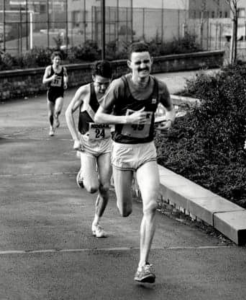
Kodak 10K, Glasgow, 1986. Stephen finishing ahead of Peter Fleming and Graham Crawford
In season 1986/87, although he did not run often, Stephen did help his club to more medals – they were second team in the National Cross-Country relay held on 24th October, 1987 at Galashiels. He ran on the fourth stage in a team of Adrian Callan, David Donnet and Graham Crawford. Adrian ran the fastest time of the day and Stephen was eleventh in a race where 108 complete teams finished.
Among Stephen’s honours in a wonderful career, which was really too short, were the three races in World Cross-Country teams in 1984, 1985 and 1986. It is worth noting that he twice moved up an age group for international duty: in 1984 he had won the SCCU Youths title and competed in the Junior race, and in 1986 he won the Junior Scottish championship and competed as a Senior Man.
All Scottish champions are talented and fast runners on whatever surface they find themselves. That’s a given. Not all courses are alike despite the trend towards flat fast grass running, and runners have preferences. When the West District championships were held on a frozen, hilly course at East Kilbride in the 70’s, many Scottish and even British runners turned up but refused to run. Similarly when the national was held on a muddy, hard, hilly trail at Livingston, several of the top men did not race. When you ask Stephen about his favourite country venues he mentions Stewarton in Ayrshire and the Braidfield Farm course in Clydebank. Both hard unforgiving venues for the event. That tells you what else the man brought to his sport – a sense of balance, yes, but also courage. To run fast down a rock strewn hill, or leap an Ayrshire burn demands both. Hard work, speed and courage were the secrets of his success. His achievements were recognised by his club and in 1987 he was made an Honorary Life Member of Springburn Harriers.
The last words come from Stephen himself. He was asked a few questions about his time as a runner,
- the first being what he regarded as his best race. “I think my best race was the Kodak 10K when I managed to run sub 30 minutes and test myself against some top senior athletes. Equally my second Scottish championship at Beach Park was probably my toughest test where Rob Carey pushed me to my limits on the day.”
- What athletes all want to know, he was asked to give some information about his training: “A typical week would look like this: Monday: 15 x 150 at full pace; Tuesday: 6-8 mile bunch run at 90% race pace with all-out assault on the last 1k; Wednesday: 8 x 400, all sub 60 seconds with 1 minute recovery; Thursday: Steady bunch run, about 8 miles; Friday: Easy jog or walk; Saturday: Race; Sunday: 20 mile easy run plus a fast 3-4 mile leg opener in the evening,”
- When and why did he stop running, after all he had just run in his first senior international. “Although it seems I did run some of the 1987 season, I really had made my mind up after the 1986 world cross-country. I was already running twice a day, four times a week. I really couldn’t see myself punish as hard while working full time on a building site. I, rightly or wrongly, though that if I can’t reach the standards of top athletes with the effort I was putting in thenI couldn’t see the point. “
- Looking back at his running career, what did he get from it? “Discipline, commitment, friendship and a sense of belonging. I firmly believe that the traits Eddie instilled in the young athletes paved the way for our futures. I personally took those traits into my working life and have continued to keep them close. Running gave me an escape from what I saw as a limited future, it opened my world to new horizons and the ability to reach my goals.”
- I have fond memories of track meetings at Coatbridge – running the 200m and doing the high jump in league meetings. I also met many fantastic people: Aidy Callan was a true gent, Eddie Sinclair a real inspiration, Steven Murphy is still my best mate and Nat Muir was an idol but very down to earth.
That is quite a testament to Eddie Sinclair, his coach, but when Stephen compares himself to the top athletes in the mid 1980’s, he is not comparing like with like. He was doing a strenuous day job and training twice a day on top of that while the top men were full time professionals, with unlimited sponsorship and back-up facilities. Regardless of that, Stephen was a genuine credit to the sport, to the club and to himself.
John Wright
John Wright winning the Junior National in 1958.
John was a very talented Junior man who also had a very successful career as a runner for the British Army while doing National Service. The following profile was done for Clydesdale Harriers and is reproduced here. Before his first junior national victory and although the club had turned out many very good teams, and had won medals (eg in 1955 they were third team in the National and won the SAAA 4 x 440 yards title on the track, it was the first individual cross country victory at national level since Dunky Wright in 1923. It reads –
“The Committee wish to place on record the magnificent performance of John Wright in winning the NCCU Junior Cross Country Championship. This is the first time any major cross country title has come the way of the club for a good number of years.” Extract from Clydesdale Harriers Minutes of 13th March 1957: it is the only time that any athlete has been mentioned in the minutes in red and is a mark of the extreme respect accorded to this superb athlete.
Partly because of this I feel that John is a good example of the club man of the time and of what the top Scottish athletes of the time were doing. His pedigree in the club was without equal. His father Harold and his uncle Willie had run for the club and then acted as trainers. This was particularly true of Willie who trained John. His grandfather Jack Wright (of whom club president Jock Kirkland said “Copy him, because in his age and your youth it was hard to tell who was the younger”) had also been a club member and a Scottish internationalist in his day. Jack’s brother George was also a very good quality athlete and both men were founder members of the club.
John is primarily known as a cross country runner and joined the club as a Youth (Under 17) in 1954. In his first run in the National Cross Country Championships was a tenth place in the Youths race – good enough but the following year he was second – only 14 seconds behind Billy Goodwin of Bellahouston Harriers and five ahead of J Ewing of Victoria Park. The team was also second – they felt that they had a good chance of winning but after John’s second place, Bobby Clark was seventh and Jackie Hislop was fifteenth but the expected fourth counter, Willie Roddick, had a poor run to finish seventy first and the next counter was in fact Denis Stirrat in thirtieth which gained second place medals for the team. They were only four points behind Shettleston’s winning team. It was also coincidentally the first time in several decades when the Senior Men won National medals being led home by Cyril O’Boyle in sixth place with George White (11th), Pat Younger (12th), John Hume (30th), Jackie Higginson (52nd) and Jimmy Young (53rd) being the other counters.
John running with the winner Pat McParland in his first Junior National
The Bible of Scottish athletics at the time was the ‘Scots Athlete’ magazine produced by Walter Ross and one of its top features was John Emmet Farrell’s Running Commentary which dealt mainly with Scottish athletics in a very knowledgeable way but also covered the international scene. He previewed the race and then reported on it in some detail and it is his words that are used below.
‘The race for the Junior Cross Country Championship of Scotland appears to be, at least on paper, to be the most open of the races. …………………..Strictly on the basis of the showing at Lenzie, P McParland of Springburn and Geo. Govan of Shettleston who came to the tape in close proximity may be installed as co-favourites with that grand little Clydesdale runner John Wright lying handy.’ (Running Commentary by J Emmet Farrell) was how it was previewed and in the next issue the following report appeared.
‘At least half a dozen runners were forward to win the title but before half distance it was apparent that only P McParland (Springburn) and John Wright of Clydesdale would contest the issue. The latter running very sweetly indeed stuck to his rival closer than a brother but could not quite cope with his rival’s stronger finish. A grand win for McParland and a good showing for Wright’s chances next year as he is still a Junior.’ (Running Commentary by J Emmet Farrell)
Result: 1. Pat McParland (Springburn) 31:26
- John Wright (Clydesdale) 31:36
- George Govan (Shettleston) 32:04
The First Victory : 1957
John kept working away and was by now one of the stars of the future in Scottish Athletics – indeed he was a ‘star of the present’ and after another year of sterling performances, he was once again a favourite for the National Junior Cross Country title by January of the following year. Emmet Farrell again previewed the event: ‘Slim, consistent John Wright of Clydesdale Harriers looks at the moment a hot contender for this year’s Championship.’ (Running Commentary by J Emmet Farrell in January 1957).
His report of the race in the next issue was the kind that most runners can only dream about: May 1957: ‘Slim, immaculately stylish John Wright of Clydesdale running with machine like precision trounced his rivals in the Junior Championship and emerged the easiest winner of the day, an ample compensation for last year’s runner up position. His form overshadowed the competent running of Edinburgh Eastern’s D. Togwell and Springburn’s J Rooney who finished in front of the more fancied Geo. Govan of Shettleston’. (Running Commentary by J Emmet Farrell) in May 1957)
Result: J Wright 31:50; 2. D Togneri; 3. J Rooney; 4. G Govan
Winning in 1957
The following year it was held again at Hamilton Race Course but over a different trail. In previous years it had been three laps of the race course proper but this time the course left the race course and went down past the Mausoleum and along the banks of the Clyde before coming back up to the course again. He won again by an even larger margin – this time from Joe Connolly of Bellahouston Harriers leaving many good men such as Tommy Cochrane and Ian Harris of Beith behind him. He went pn training and racing and went into 1958/59 in good heart.
One of the questions that any athlete would/should be asking at this point would be about the training he was doing to get these results. Well, he was training six days a week, never training on a Friday. His week went as follows.
Saturday: A race or an inter club run.
Sunday: 12 laps of the perimeter at the Recreation Ground at Mountblow in Clydebank. The perimeter was a fairly accurate half mile and his coach, Willie Wright, always believed in a fast start to be right up with the race. This meant a first lap in about 2:07 followed by another in about 2:12 before settling in to laps of 2:20. In other words a mile in 4:19 followed by five in 4:40. It would be a very good session to-day.
Monday: He would usually run from his home in Linnvale, Clydebank, out to Anniesland Cross (going round the outside of the toilets at the furthest point to make sure the distance was always the same) and back. This was just under 5 miles and took a bit over 23 minutes. It was again a fast run.
Tuesday: It was a club night so he would train from the Baths in Bruce Street with the pack over distances of 10 or 12 miles most nights.
Wednesday: Willie Wright was friendly with Allan Scally the Shettleston Harriers coach so on Wednesdays he would go to Helenvale track in Glasgow and train with Graham Everett. Where Willie usually got John to do repetition 400’s with 400 jog recovery (which was pretty standard for the time) Scally kept the 400’s in 58 or 59 seconds and progressively reduced the intervals until they were doing 15 x 400 inside 60 seconds with 60 seconds recovery. This of course was on a cinder track. (Graham was also an excellent cross country runner but was better known as seven times Scottish One Mile Champion and British Mile Champion who defeated Murray Halberg (New Zealand) for the title).
Thursday: Another club night but he would only do an easy 4.5 or 5 miles if he was racing on the Saturday.
Friday: He never ever trained on a Friday.
In 1958, like every other top athlete in the country he wanted to make the team for the Empire Games in Cardiff but only just failed to do so. The trials were at the Scottish Championships and he ran in the Six Miles on the Friday night where he finished third in 30:22.8 and with three to go he should have been selected. But the selectors decided instead to take only the first two finishers and add in Ian Binnie who had run but dropped out. On the Saturday John could do no better than sixth in the Three Miles in 14:40.2. The track at Meadowbank was very poor and cut up dreadfully so that after the first couple of laps, the runners were running in the third lane. Most of the athletes signed a letter of protest to the SAAA’s about it. It was a disappointment but nothing compared to the disappointment the following year over the country.
Winning the Junior National in 1958
Although known as a country specialist he was clearly also a considerably good track runner with wins in many open and highland games meetings such as Shotts, Strathallan, Bute and Cowal. On one occasion he ran the first stage in the Scottish Medley Relay Championship at Cowal and although not an 800 metres specialist he was barely two metres down on Mike Rawson of Birchfield at the changeover and ahead of some top class half milers such as JP Paterson and Neil Donnachie.
After a good season in 1959, he finished a very good ninth in the Senior National Cross Country Championship of 1959 in a bunch of three with Connolly (Bellahouston), Ross (Edinburgh Southern) and John being seventh, eighth, ninth. The selectors decided to take only seven to Lisbon and John and Ross were told they were reserves but not travelling. The runners spoke to each other and agreed to pay their own fare out to Portugal. Their clubs put up most of the money and then they were told that there was only room on the plane for seven. They couldn’t come. It was finally revealed that most of the plane seats were taken up by officials. On the day one of the selected seven athletes couldn’t run and John’s name was actually printed in the official programme. It was this event that led to him joining the Army to do his National Service – all 18 year olds had to do two years of National Service but like many others John had had his deferred because he was doing an apprenticeship in Singer’s Factory and could have had a further extension but he was so peeved that he decided at that point just to go and do it then.
When he reported to Oswestry for six weeks square bashing (ie basic training) he saw that they had a running track and asked one of the regulars if he could do some running. The guy happened to be the regimental cross country champion and John didn’t get the permission. After basic training he was posted to Germany and won the regimental championship despite going off the course and then represented the regiment at the Area Championships where he beat the much more fancied runner from the Gordon Highlanders. They soon approached his regiment asking if he could be transferred to their Unit where he would be expected to train and run and ould have every facility to do so. Without asking him, the offer was turned down and he stayed with the regiment. He won the Divisional Championships and went to the BAOR Championships at Dusseldorf where he finished second to Ben Grubb – British International cross country and steeplechase runner. He ran regularly thereafter with such as Ernie Pomfret (another GB Internationalist), Tommy Cochrane of Beith and other high quality athletes.
He also joined a German club – MTV Celle – and ran for them regularly with good results with his friend Terry Wells who had not been a runner before joining up. He enjoyed this time and combined the club running with Army duties. When he left the Army he was running really well after training and racing with guys such as Pomfret and Grubb. He ran a time trial over 3 Miles and was inside 13:30 which looked good for future athletics. When he came home, the club had moved to a new 440 yards track at Whitecrook from the 330 yards track at Mountblow. It was terribly soft and cut up easily to such an extent that the Council added some material to it to make it more robust. Meantime, John had run on it and decided that it was too soft for serious training and returned to train on his own at Mountblow. One of his sessions involved repetition 330’s. After 10 reps he was going well so he stepped up to 12 and then decided to go to 15 and end the session there. On the 15th rep he tore his Achilles tendon. Doctors repeatedly told him to rest, and the pain was always still there when he returned to training. He was advised to see physiotherapist Walter Kinloch at Corunna Street in Glasgow. This required a medical referral and the doctors would not recognise the physiotherapists qualifications or professional body. No treatment was possible. And John’s career ended in a way that would be unthinkable at any point over the past twenty or thirty years.
However, good club man that he was, he kept on running for the club and served on the Committee for almost another twenty years.
Cammie Spence
Cammie running in the Six Stage Relays
Cameron Spence, known to everybody as Cammie, was born on 19th July in 1950 and ran for five Scottish clubs (with an affiliation to one Irish outfit). The Scottish clubs were Greenock Glenpark Harriers, Greenock Wellpark, Spango Valley, Inverclyde and in the summer of 1973, for Shettleston Harriers. On the track he was ranked nationally from 1972 to 1988 in 3000 m, 5000m and 10000m with personal best times of 8:40.8, 14:27.6 and 30:00.84. On the road there are times of 64:18 for the half-marathon and 2:28 for the marathon. All good times and he was really competitive whatever the surface. He hated the track because “it was so bloody hard” but he did run it in championships and in Highland Games. Nevertheless, he is better known as an international cross-country and road runner.
He started as a boy with Glenpark between eleven and fifteen years of age, and ran in his first major championships in 1960/61. He was fifth in the District Championships as a Junior Boy and then 63rd in the National at Hamilton. Of these early days he says “Running was in the family. My 3 older brothers, Jim, George and Gordon all ran. So at the age of 11 I joined Glenpark Harriers. My first coach was the legendary Bill Elder. He coached all the youngsters in the club at that time. I only trained twice a week, Tuesdays and Thursdays. Short run followed by circuit training. To this day I can still be dab hand at skipping!”
His father was a football player of talent and had been approached to play for a senior professional team and Cammie followed in his footsteps for four years or so. He played at the top amateur level before coming back into athletics in 1970. He trained for a while with younger brother Lawrie and they were coached by big brother Jim. With some encouragement from big brother George and his wife Pat, Cammie then moved to Greenock Wellpark Harriers where he coached himself. His first run in Wellpark colours was in 1970 at Bute Highland Games. It was in the Mile Handicap where he was the back marker. The family in the form of Jim and George complained to the handicapper because Cammie was a novice, saying that it was his first race in five years and he shouldn’t be the back marker. The handicapper would not change his mind. Cammie, however, finished 4th and at the following week’s Cowal Highland Games he finished third on the Friday and, it being the age of the amateur, won a plaque. He still has it. The family bond was always important and when Cammie was asked if any person or group had a marked influence on his attitude or his performances, he says without hesitation, “I would say my oldest brother Jim. He was very enthusiastic about athletics and installed discipline into my training.”
Cammie is known as a hard runner and a real competitor. He never just ‘ran round’ a trail in his life. Maybe that’s why the photograph above is labelled ‘How to Hurt’! He became a senior athlete in 1971/72 and he competed all the way through to the twenty first century. One of the really big events during his time in the sport was the eight man Edinburgh to Glasgow relay and Cammie ran in no fewer than twenty one of them between 1968 and 1998 for four clubs. The toughest stages of a race with no easy stages were the second and sixth. His record was 1st Stage x 2, 2nd Stage x 3, 4th Stage x 1, 5th Stage x 4, 6th Stage x 9, 8th Stage x 2. He represented Glenpark in 1968 and ’69, Wellpark in 1970, ’71 and ’72, Spango Valley in 1977, ’78, ’79, ’81, ’82, ’83, ’84, ’85, ’87 ’91, ’92, ’93, ’94 and ’95, and Inverclyde in 1998. Remarkable.
Cross-country was his forte however. Spango Valley AAC was founded in September 1973 and Cammie was one of key men there right from the start. A very good all round team they seemed to be specially good in relays and the part Cammie played (he was team captain for 20 of the club’s 25 years) was tremendous. In the District Relays, they won gold, silver and bronze and Cammie ran times in the top ten most years and although they never won the six-stage road relays, they won lots of metal there as well. He was a really good team player. How was he as an individual? We can look at his championship record.
In 1972/73 the Glasgow Herald report on the South West District championships read: “The Spence brothers, running for Glenpark and Wellpark respectively, dominated the South Western District Championships. Laurie Spence was an easy winner of the senior/junior title by no less than 270 yards from his brother with Dick Hodelet a similar distance away third.” Glenpark won the team race with Wellpark third. In the National championships at the end of the season, Cammie was 27th in the Senior race while Laurie was second in the Junior event running for Strathclyde University. Running for the new club of Spango Valley AAC in the 1974 National at Coatbridge, Cameron was 17th while Lawrie was fourth in the Junior race. The improvement was year-on-year by now and in 1975, Cammie won the last South-West District championship ever held by over half a minute with former team mate Bill Stoddart third. This was followed by 41st in the National at Coatbridge.
In season 1975/76 the South West District merged with the Midland District to form the West District – a much tougher outfit with good results harder to come by. In the Championships, neither Cammie nor the club were placed and Cammie missed the National held again at Coatbridge.
The rivalry between Cammie and Lawrie had not yet started to heat up and in the District Championship Lawrie was eighth and Cammie 21st. In the National in 1977 Lawrie was fourth and Cammie was 26th. The following year on a very hard and rutted course at East Kilbride Lawrie won from Phil Dolan of Clydesdale Harriers and Cammie was not able to run. In the National however, Cammie had the beating of Lawrie when he finished twelfth to Lawrie’s fifteenth. Time difference? 22 seconds. The rivalry was probably at its best over the next few years Both quality cross-country men, they had some real battles over the years with Lawrie generally coming out on top. Neither ran in the District in 1978 and Cammie also missed the National where Lawrie was second.
In the District championships in 1979/80 Cammie was third but they met up again in the national where Lawrie was fifth with Cammie tenth. Difference? 47 seconds or 200 yards+. The following year Lawrie was fourth with Cammie 12th, and so on with the gap being about 200 yards at the finish. When Lawrie finished at Strathclyde Unversity he returned to Greenock and joined Cammie at Spango Valley AC. Inevitably there was some sibling rivalry in evidence. When asked, Cammie says, “Of course there was, at times, between Lawrie and myself. I always enjoyed beating Lawrie in races – which wasn’t very often. He wasn’t as keen for me to do it! Some of our sessions we did in the Battery Park in Greenock were legendary, and boy did they pay-off for us!”
As founder nations of the Cross-Country International Scotland, England, Ireland and Wales ran as separate nations in the World Cross-Country Championships up until 1985. It was a wonderful time and the effect on Scottish distance running was entirely beneficial. As well as the International there were several international fixtures on the continent for four man teams – Elgoibar in Spain, Hannut in Belgium, San Sebastian in Spain and so on. The opportunities were there if you could take them. Cammie was fortunate enough enough to have the talent that could take him to the necessary standard. After running for a short time for Scottish representative teams at a time when the standard was high, he had the opportunity to race in the biggest race on the calendar for Ireland.
Asked about the Irish connection, he said “It started in 1979 when I fell out with the Scottish selectors. I won the International race at Stirling University grounds running for Scotland in 1978. Won it quite easily and was picked to run in Belfast (which was cancelled due to the Troubles), and San Sebastian on the back of that win. Then went to Spain and picked a bug up (likely on the plane) and ran poorly. When I got home I had a chest infection. Missed training for a number of weeks and as a result missed the National but asked the selectors to consider me for the Worlds. They didn’t.
Meanwhile Rod Stone (Cambuslang Harriers) from NI asked Lawrie and I if we would like to run for Annadale Striders at the NI Senior Cross-Country Championships. We had Irish qualification through our father who was born in Belfast (and how did they find that out?). We both agreed and joined the Striders. Lawrie finished second and I was sixth. They offered us places in the NI team for the Worlds. I said yes and Lawrie said no. I got International clearance quickly. I went to Limerick for the Worlds and beat half the Scottish team. I had proved a point. It was the best move I ever made.”
He had to qualify for selection by running in the Irish Senior National Cross-Country Championships and the result was that Cammie ran for Northern Ireland in Limerick in 1979, in Paris in 1980, in Madrid in ’81, in Gateshead in 1983 and in New York in 1984. In Limerick they were almost side by side at the finish – Lawrie was 193rd and Cammie 194th and in New York they were team captains. Not limited to the Worlds he turned out in international races at Milan and Buussels on the continent, Gateshead, Stirling, Cumbernauld and in road races in the south of Ireland too. It was a great time for the event and cross-country has a high status in Ireland – Cammie ran in teams with Greg and Gerry Hannon, Paul Lawther, John McLaughlin and many other well-kent athletes.
Family rivalry was now raised to international level. Asked about the duels with Lawrie he said: ” Yes – at the Worlds and various other events. I have stories about us and our battles over the country. Now here is a question for you. Who are the only brothers to captain different nations at the World Cross-Country Championship. And what year and place? Yip, Lawrie and myself were the captains of Scotland and Northern Ireland respectively at New York in 1984. What a honour for us. Pity our dad had died two years previously.”
Cammie in his Irish vest
Of course there was life after the World Cross-Country Championships – 8 of his Edinburgh to Glasgow Relays for a start. Cammie is a runners’ runner, he turns out for his club as readily as for his country, he turns out for the sake of the race regardless of whether there is a club team or whether he is running as an individual. He continued to do so as well and as hard as he always did. There was something he had not tried yet though. In the 80’s the marathon was the thing. Everybody ran the event – young people, old people, very old people – and there are no prizes for knowing that Cammie ran the event. He says:
“I hated marathons. 20 miles and body switched off. Every time except…………………in 1984. I ran at the Cowal Games on the Saturday in the 5K. 2nd to Lawrie in 14.53. Then it was 8 pints of lager and Chinese meal after. My wife got me up at 9.30am on Sunday morning saying I had promised to run the Inverclyde Marathon with Terry Wilkie. I had just remembered after the 5K he asked me. So I had a cold shower to wake and sober up and get a entry on the day (morning) and got to the start line just in that ime. Off we went. Time passed by in a sort of blur. We stopped for water, we stopped for sponge fights, we stopped to get our picture taken. Our last stop was just before the mile to go mark.
“Terry was struggling. I wisnae bad. Didn’t have a clue about time, but there were two Kilbarchan runners coming and I said to Terry we can’t let them beat us. He told me to go away. He just wanted to lie down. I wouldn’t let him, Got him going. We finished with a time of 2.35. I couldn’t believe it. Could have been 2.34 but we stopped again to pose for pictures before the finish. There is no justice. Didn’t train for it; raced the day before; drank too much the night before. I still don’t know how I managed it.”
Clearly fit and well but the twenty first century had a nasty surprise for Cameron Spence.
ATHLETE TO KEEP RUNNING DESPITE HEART PROBLEM
The above headline appeared in the Greenock Telegraph in 2010 and started: “An international athlete from Greenock discovered that his heart stopped beating during the night – but is now amazingly back running. Cameron Cammy Spence was diagnosed with exercise induced asthma two years ago and had to give up running – but it was actually his heart that was causing breathlessness during exercise. He has been fitted with a heart pacemaker and is back pounding the streets as well as being involved in worldwide research that could save lives.
Superfit Cammy was given the shocking news about his heart after a specialist at Inverclyde Royal Hospital said he wasn’t convinced he had asthma and arranged for him to get a mobile heart monitor. Cammy said “I had the monitor on for 24 hours and it showed my heart stopping twice during he night for 4.5 seconds at a time. I couldn’t believe it. There is no history of heart problems on my mother’s or father’s sides of the family. I felt numb.
Now the Inverclyde Athletic Club coach wants to warn other runners that they too might under certain circumstances be in danger of damaging their hearts.”
Cammy then discovered after reading a magazine article that he wasn’t the only runner diagnosed wrongly with asthma instead of an irregular heart beat. Now the Inverclyde Athletic Club coach wants to warn other runners that they too, under certain circumstances , could be in danger of damaging their hearts. He said, “Just as I was getting diagnosed for an irregular heartbeat there was an article in “Athletics Weekly” by oneof the regulat writers who has the same problem. “
Cammie got in touch with Martin and many Scottish runners then got in touch with him about it. His belief is that hard training when running through colds and ‘flu may be the cause. Remember he was running when all the regular road runners, not just the internationals, were running 70 – 100 mpw. The whole article can be found at: http://www.greenocktelegraph.co.uk/news/14001294.Athlete_to_keep_running_despite_heart_problem/
The cardiologist who diagnosed the problem was very keen to find out more about it and was very interested in Cammie’s work with Martin through AW. Right now, he says that he was happy with the pacemaker but at present and for the last two years it’s not as good. He still runs but feels more tired, even when jogging. It is an ongoing problem and he is discussing it with his new cardiologist.
*
Cammie is still very involved in the sport. Let’s count the ways!
- He has been coaching for many years. It was easy for him to do the coaching, he says, as he had been coaching himself from 1976. He was always experimenting.. When Spango were at their peak in the 80’s most of the guys at IBM were doing Cammie’s sessions. Heencouraged them and says it was great to see them improving.
- Administration. He has been doing that for a very long time as well. We have already noted that he was club captain at Spango for 20 years of its 25 years in existence. He was also the first captain of Inverclyde AC when it was formed in 1998. Vice President in 1998 and then President of the Scottish Veteran Harriers Club, plus was the handicapper, race convenor, timekeeper, recorder.
- Then there was the Cowal Highland Gathering. The Games committee asked if he was willing to bring athletics back to the Games. This was 1996. Of course being Cammie, he said he would. He says: “Cowal was wonderful. Running if front of 20000 people was amazing. So it was May ’96 that I had a meeting with the Captain Eric Brown, committee member, on the Western Ferries So over 2 sailings between Gourock and Dunoon I had my plan accepted and the athletics would start again at that years Games. Had my ups and downs at Cowal. Down bits caused by the Scottish Pipe Band Association. The up bits were the athletes who supported me. I’m sure they all enjoyed the experience. I stepped down last year after 20 years as athletics convenor. I always intended that the Dunoon folk should look after their Games. Now happening.”
- He has also been involved with the Bute Highland Games since he himself first started competing there in 1970. Over the years he slowly drifted into becoming an official and is now athletics convenor. “I canny help myself, he says.
- Now there is the Renfrewshire AAA’s. President. Stand in Secretary, Treasurer, timekeeper, recorder. Been Colin Shield’s back-up for many, many years. Colin retired last year. His health not that great. 40 years he has been involved with the county. Looks like I’m going that way too.
We asked Cammie to reflect on his running career and he came up with the following responses.
Looking back, Cammie, what exactly did you get out of the sport?
Friendships. The people I met during my running career were all wonderful. From Joe Jogger to World and Olympic Champions. And the many officials as well. It was the friendships that were created and they still last today.
Can you describe your general attitude to the sport?
It was hard work at times but I enjoyed the training and taking part in races. Especially the racing.
What do you consider your best ever performance?
It was actually one year, 1979.
*I had always wanted to win a District Track title (10K at Coatbridge).
*I won the Gourock Highland Games Road Race(remember watching the road race as a wee boy and thinking I want to win that).
*And racing at the World XC Championships for the first time.
It was some year for me. The only down side it was a couple of years until I got my motivation back. So the moral of the story is, and something I tell my athletes “You can always do better”.
And your worst?
All my marathons. (Except the Inverclyde one in 1984. Which made me question why was I doing them?).
What goals do you have that are still unachieved?
My goals are for the athletes that I coach. I want them to get the best out of themselves. I think I achieved mines.
What would you have changed about your athletics career were you able to go back?
When I started running again there was only Ravenscraig Stadium for us to do our quality sessions. It was a cinder track. It was either brick hard or like a bog. You know what Greenock is like for rain!!! It was blisters or getting covered in wet dirty cinders. So it was the Battery Park and on the grass which I developed for doing our speed work starting in 1976. If we had a decent track maybe my track times would have been better. But the Battery did help me pick up a lot of prizes at the Highland Games hmmm. So to answer the question, if I had a decent track to train on maybe, just maybe, my track times would have been so much better. That would have gave me a lot of satisfaction.
Ran for Scotland quite a few times on the country. I would call them B vests. And was involved in the international training sessions, usually at Livingston on a wet Sunday.
I ran for the Scottish Vets. I did offer my services to the Northern Ireland people when I turned 40 in 1990. They didn’t respond for some reason. So I was more than happy to put on the dark blue vest once again. But I decided in 1996 I had had enough of International competition. I just didn’t want the pressure any more.
What do you think of the sport now that it is ‘more professional’ in its set up?
It was better run(ex the pun)in days gone by. But things are starting to improve. Scottishathletics are slowly starting to realise that the clubs are the mainstay of the sport. But there is too much emphasis on the younger athletes and not enough encouragement for the older ones. As I say the young ones come and go. The seniors are the mainstay of the clubs. The “professional” athletes we have are having money flung at them. When they are good enough they will get invites and appearance money to the larger events. They don’t need the sports body to support them.
What advice would you give a young person coming into the sport for the first time today?
Athletics are there to be enjoyed. You can only do your best. You are going to have good days and bad ones. Don’t expect too much too soon. You only get out of the sport what you put into it.
And my favourite saying “You are as only as good as your NEXT race. You learn from the last one”.
One of his former rivals, Colin Youngson (three SAAA Marathon titles, 10 marathon medals in total, and SAAA 10 miles track champion) has some good memories of racing Cameron. He says
“To other runners, Cammie was well liked and respected as a fighter, a terrier – someone who could be relied on to battle as hard as possible and seldom even considered easing off – a very difficult man to beat, or stave off, if he was chasing you. He and I were occasionally close rivals, although his forte was cross-country and mine road running, especially marathons, which he did not enjoy.
Since I am nearly three years older, when we first raced against each other, on Stage Two of the E to G in 1970, I was a fair bit faster and the same was true on Stage Four in 1972. However by 1982 on Stage 2 he outpaced me quite easily, although I got my revenge on Stage Five in 1984 and 1985.
In the National Senior Cross Country, Cammie definitely had the edge. Although I finished in front of him in 1972, he outkicked me a year later. The last time I beat him in this prestigious event was in 1975. After that it was Cammie all the way, although 1978 was close – I was thirteenth and he was one irritating place in front! In 1980, although he beat me easily, I had the consolation of being ESH captain and a counter in their winning team.
An interesting encounter took place in October 1981 at the Allan Scally Road Relay. I had moved back up north and rejoined Aberdeen AAC. Since I was not particularly fit, I assumed that this event would merely provide good training. However Peter Wilson and Fraser Clyne ran well and then Graham Laing came back to form with a bang – handing me a totally unexpected 39 second lead! Cammie closed inexorably and by the finish, although AAAC did hold on to win, it was only by eleven seconds!
After he became a veteran by turning 40 in July 1990, we renewed our rivalry and had quite a few close contests. In the 1991 Scottish Vets Track Champs, I did manage to beat Cammie over 5000m, but he had raced the 1500m previously. Aberdeen was the venue for that year’s Home Countries Veteran Cross Country tussle. I was in the Scottish first team and Cammie in the second team. However I suffered badly from catarrh and, after starting too fast, began retching and struggling. Cammie’s unsympathetic voice rang out just behind me, “For God’s sake, Colin, if you’re going to die, just die!” He moved ahead, out of earshot, and ended up a respectable 11th, with me a disconsolate 16th.
At the Kelvin Hall Scottish Vets Indoors in March 1992, Cammie and I had a real fight in the 1500m, before he sped away to win in 4.16.3, while I was happy enough with 4.17.4. Then he beat me into third in the 3000m. Dougie Mackenzie won, with Cammie recording 8.56 and me three seconds behind. At the end of the same month the 8-Man Alloa to Twechar relay took place. Cammie won Stage Stage Two; I was fastest on Stage Seven and AAAC were first team home.
Saturday October 31st 1992 was a red letter day for me, and Cammie made me fight very hard. I had just turned 45 and was very keen to do well in that category at the Five Nations Vets XC event in Belfast. The rest of the Scots team arrived on Friday; but Cammie flew in from Glasgow that morning. I started fast but Cammie caught up and we ran closely together until there was less than a lap to go, when I edged away to finish 6th (and first M45, also leading my age group team to Gold), while Cammie was a fine 9th and led the Scots M40 team to Silver medals. Then he flew straight back home!
In 1993 I did manage to beat Cammie over 5000m in the Scots Vets Track; and in 1994 finished 4th in the Scots Vets XC, one place in front of him. However in 1996 Cammie Spence beat me very easily in the British Veterans Half Marathon Champs in Monkland.
Looking back, we were very well matched and enjoyed a long friendly rivalry.
Always a contributor to the sport, Cammie became President of the Scottish Veteran Harriers Club. When I started as editor of the club newsletter, Cammie submitted a lengthy account of the SVHC Easter trip to the sun in Lanzarote, a thoroughly enjoyable trip which he had helped to organise for many years. Social events in 2014 included daily runs exploring the local area, darts, sunbathing, Bingo, hotel entertainment, several refreshments, water flumes, climbing a volcano, a barbecue, cycling and a 5 km road race!”
And one of Colin’s key phrases was “always a contributor. Many, many people take part in the wonderful sports of road and cross-ountry running and almost all retire more or less gracefully after their competition dys are done. But the spport relies on such as Cammie who after a long career as a runner give back at least as much as they have got out of the sport. In Cammie’s case the return has been considerable.
Des Austin
Des Austin was a very good road and cross-country runner with a best marathon time inside 2:20 but one who as a younger runner was not a stand-out performer. There were no big championship victories as an Under 13 or Under 15 or, indeed at Under 17. Des was good enough to complete the questionnaire for us and it makes an appropriate starting point.
Date of Birth: 15/2/1945
Club/s: Victoria Park, Manchester Harriers, Invicta, Highgate
How did you get involved in the sport to begin with? Athletics was not taken seriously at my school, but I started there going out for runs on my own. Was awful to start with, scraping into Glasgow University’s second team and finishing nearly last in all my youths’ and Inter-University races. It could only get better!
Personal Bests: 5000m – 14.34, 10K (Road) – 29.45, 10 Miles – 49.27, Half-Marathon – 65.33, Marathon – 2.19.19
Has any individual or group had a marked effect on your performances or attitude to the sport? Encouragement/advice from Vicky Park clubmates, especially the wonderful Andy Forbes, was crucial to improved performances.
What exactly did you get out of the sport? Testing myself, sense of achievement, making lifelong friends, travelling to interesting (and not so interesting!) places. Primarily, though, I ran, and still do, because I love running for its own sake – no other reason needed.
What do you consider your best performance? Fourth in Scottish Junior Cross-Country Champs 1966, behind three classy athletes – Ian McCafferty, Eddie Knox and Alistair Blamire, especially as I never thought of myself as a cross-country runner. Also enjoyed passing about 30 runners in the last 3 miles in first London Marathon to finish 18th.
Your least good? I won’t even go there. Don’t do negativity any more. No regrets!
Can you give some idea of your training? Big miles or high quality? Once I started working tried to keep things simple. 80-100 miles per week, mainly achieved through steady running to/from work, with long run at weekend and one session of fartlek.
Have you any thoughts on the sport today or its development? It’s great to see so many people, of different shapes and sizes out running. Well done to Paul Sinton-Hewitt for starting Park Runs. I’ll leave it to greater minds than mine to work out why the standard of distance running is so poor today in the UK.
Did you/do you have any heroes in the sport? Too many have had to be taken off my list now, I’m afraid. Lasse Viren was the first to go. Still more revelations on doping to come, on that I have no doubt. I do love watching Laura Muir race.
*
I first became aware of Des when, as a member of Clydesdale Harriers, I noted a frail-looking young entrant in the club’s Youth Ballot Team Race of 1964 sitting on his own in Bruce Street Baths pinning numbers on a Glasgow University vest. There weren’t many University runners who were still eligible to run as Youths. He was unplaced in the race. He next came to my notice in the Midland District championships at the Renton in 1965 when he finished 54th in the senior championships and out of the medals in the Victoria Park team that was second in the championships. Not bad bearing in mind how heavy that trail always was, the severity of the big hill and the fact that he was running against seniors and juniors. He followed this with 23rd in the national junior championships to win a team bronze in the four man Victoria Park team led home by Iain McPherson in 15th place. Others in the team were Pat Maclagan and John Lees.
*
The following winter season (1965/66) he was a member of the Victoria Park team that finished fifth in the District relay at King’s Park, Stirling, on 30th October. The next big one was the Edinburgh to Glasgow eight man relay on 20th November where he ran the seventh stage in the team that finished third. He had the third fastest time on the stage, faster than Stark of Edinburgh Southern, Gillon of Edinburgh AC and other well known runners. In the traditional start to the new year he travelled to the Nigel Barge road race at Maryhill on 8th January. The club team was second, and Des was 12th behind Hugh Barrow (5th) and Pat Maclagan (10th) Back on the championship trail, he was second VP runner in the District championships proper, held on 15th January at Strathleven Estate, Dumbarton, when he was 16th, behind Pat Maclagan in ninth, one place ahead of John Lees, and two in front of Alastair Johnstone. The team won and it was only the first team gold for Des. His progress continued apace and he was fourth in the junior National at Hamilton Racecourse behind McCafferty, Knox and Blamire. This was the run that Des has said he considers his best. The three in front were all ‘stars’. McCafferty was one of Scotland’s best ever runners whether he was running on the track or over the country, Eddie Knox won gold, silver and bronze in the World Junior Cross Country championships and Alistair Blamire was an extremely talented athlete who represented Scotland on track and country. As far as the VPAAC team was concerned, he led team mates Reilly, Johnston and Lees to first team medals. He really was progressing in leaps and bounds. A bit unfortunate not to gain his international vest, he was probably just too old for the international junior age group and not yet established enough or far enough up to make the senior team.
That summer, 1966, was the only time he was ranked as a track runner when he ran six miles on the track in the good time of 30:37.6.
There were many county relay championships in the 1950’s and 60’s including a Glasgow Relay Championship and in October 1966 Victoria Park won comfortably with Pat Maclagan on the first stage finishing just behind Maryhill’s Jim Brennan but Alastair Johnstone gave them the lead at halfway and Des and John Crawford increased the lead all the way to the finish. Later that month, 22nd October, it was the domestic Victoria Park championship and Des was fourth behind Barrow, McLaren and Maclagan. The moth ended with the Midland District Relay Championships at King’s Park in Stirling on 29th October where Motherwell YMCA ran out the victors and the battle between Mills of Dumbarton and Middleton of Springburn for third place grabbed the attention of the press and spectators, Victoria Park was second team with Barrow, McLaren, Maclagan and Austin the men responsible. With the Edinburgh to Glasgow Relay looming, many clubs held trials to select their eight representatives. The Victoria Park trial was on 12 November and the result was a win for Hugh Barrow with Des Austin in sixth, one place ahead of Joe Reilly. This was to the second of his six runs in the relay and he was equal second fastest on Stage Seven and Victoria Park secured second place. Then in 1970 it was bronze once more after Des had run on Stage Four. The only other championship race coming up was the Glasgow championship and Victoria Park won it comfortably with six of the top eight runners. His second fastest time and sixth handicap placing in the club’s Christmas Handicap towards the end of December ended the year for Des.
By then he had moved south to work running for various English clubs over the years – Manchester first, then Invicta (in Kent) and eventually Highgate Harriers in London. However Des Austin became serious about his running once more in the late 1970’s. Running well south of the Border, he returned to run in the E-G in 1978 and promptly won his fourth team medal – silver this time, with Des tackling the exposed Stage Five straight into a blizzard, retaining second place and ending up third fastest, only ten seconds off the fastest. Five medals in five attempts was his record in 1980 when VP were third and he ran Stage Six. It is not true that after Des’s Scottish club could only manage fourth in 1981 despite his efforts on classy Stage Six (sixth fastest), Des Austin refused to compete in the race again, since he had finally failed to win a medal!
By then the main focus for Des had become the marathon, although he finished a good fourteenth for Victoria Park in the 1978 senior national at Bellahouston Park. At this time he was the owner of ‘Runners Need’, a specialist sports shop in Camden, London. In 1979 he ran 2:24:58 at Harlow, finishing tenth. On schedule for 2:20 at 20 miles he then ‘hit the wall’ with a vengeance and vowed he’d never do another one. Not the first to ever make such a remark, I think! He was doing 7 minute a mile pace when Les Presland went flying past. That year he also ran 10,000m in 30:44.
In 1980 He ran the Preston to Morecambe in 2:19:30 to be second to Mike Critchley but 1981 was a very good year. Have a look at these:
- 2:20:16 in London for 18th
- 2:19:21 for 9th in Sandbach
- 2:23:20 in the British Pony Marathon in Bolton for 2nd;
- 2:19:19 in Glasgow where he was fifth.
The Glasgow time was achieved wearing the Scottish international vest: Jim McGlynn from Eire was less than a minute in front of him, with Alan Coles (Wales) second and Rod Stone (Northern Ireland ad Cambuslang Harriers), Colin Youngson, Des Austin and Alastair Macfarlane representing Scotland finishing closely together, Scotland won the team race and received specially inscribed SAAA gold medals.
Des Austin continued to record marathon times in the 2:20s for some years and as a veteran did very well
- in Chicago (1985: 47th/2nd Master in 2:24:49). Chicago was also a very nice pay day with a cheque for several thousands of dollars!
- London (1987: 74th/1st British vet/3rd vet overall in 2:24:14)
- Boston (1988: 90th/6th Master in 2:28:38).
In 1988 he became owner of ‘Runners Need’ (as mentioned above) and by the time he sold the business in 2010 there were seven branches, and it has continued to expand.
It is all to common to see young athletes who do not succeed give up the sport before they even reach the ranks of Under 20’s: Des is a lesson to them all. One of Scotland’s Olympians at the start of the century was of the opinion that men succeed more from the lessons early failure than early success. It didn’t take Des too long to learn from the lessons taught by the Glasgow University second team!
Hugh Barrow and Des at the back; Albert Smith and Alastair Johnston in front. September 2016
Des Austin – Marathon Career Record
| No | Date | Venue | Position | Time | Winner (Club) Time |
| 1 | 27 October 1979 | Harlow | 10 | 2:24:58 | Ian Ray (Salisbury) 2:16:04 |
| 2 | 19 July 1980 | Morecambe | 2 | 2:19:30 | Mike Critchley (Bolton) 2:18:17 |
| 3 | 29 March 1981 | London | 18 | 2:20:16 | Dick Beardsley / Inge Simonsen 2:11:48 |
| 4 | 21 June 1981 | Sandbach | 9 | 2:19:21 | Andy Robertson (Army) 2:14:23 |
| 5 | 23 August 1981 | Bolton | 2 | 2:23:34 | Stan Curran (Salford) 2:19:32 |
| 6 | 18 October 1981 | Glasgow | 5 | 2:19:19 | Jim McGlynn (IRL) 2:18:24 |
| 7 | 09 May 1982 | London | 52 | 2:22:28 | Hugh Jones (Ranelagh) 2:09:24 |
| 8 | 13 June 1982 | Gateshead (AAA) | 60 | 2:36:36 | Steve Kenyon (Salford) 2:11:40 |
| 9 | 17 October 1982 | Glasgow | 20 | 2:24:56 | Glenn Forster (ENG) 2:17:16 |
| 10 | 30 May 1983 | Gillingham | 2 | 2:23:56 | Terry Osborne (Royal Navy) 2:23:04 |
| 11 | 23 October 1983 | New York (USA) | 631 | 2:46:00 | Rod Dixon (NZ) 2:08:59 |
| 12 | 20 October 1985 | Chicago (USA) | 47 | 2:24:49 | Steve Jones (WAL) 2:07:13 |
| 13 | 02 November 1986 | New York (USA) | 398 | 2:48:05 | Gianni Poli (ITA) 2:11:06 |
| 14 | 10 May 1987 | London (AAA) | 74 | 2:24:14 | Hiromi Tanaguchi (JAP) 2:09:50 |
| 15 | 18 April 1988 | Boston (USA) | 90 | 2:28:38 | Ibrahim Hussein (KEN) 2:08:43 |
| 16 | 23 April 1989 | London (AAA) | 130 | 2:28:12 | Douglas Wakiihuri (KEN) 2:09:03 |
| 17 | 22 April 1990 | London (AAA) | 198 | 2:30:42 | Allister Hutton (Edinburgh SH) 2:10:10 |
George Craig
Scottish Cross-Country team, 1949. Craig third from right in the back row.
George Craig was the son of Archie ‘Baldie’ Craig of Bellahouston Harriers who had won the national cross-country title in 1913 and five cross-country international vests and the younger brother of Archie, junior, who was a member of Shettleston Harriers and ran for Scotland in the cross-country international in 1938 and 1939. There have been many remarkable family groups in Scottish athletics – Dundee’s Hasketts and Gunstones, Greenock’s Spence brothers and others. No one has had a father and two sons run for Scotland to the best of my knowledge, although the Brown family from Motherwell came close – Andy and brother Alex both represented the country but although father Andy was a very good runner, he never had a Scotland vest.
George was the younger of the two brothers and he first came to prominence in 1935 at the age of 16 when he won the Scottish Youths National Cross-Country Championship. The Glasgow Herald reported on the race as follows:
“As was generally expected, Springburn Harriers with three of last year’s winning team available, scored a comfortable victory in the Youths championship. …. There was however a surprise in the individual race, G Craig (Shettleston Harriers) bowling over several more fancied candidates. It was in a way a remarkable performance for a Youth of 16 years, particularly as this was but the third race he has taken part in. He is the son of A Craig, the well-known member of the SAAA committee who won the national championship in 1913 and who figured in several internationals.”
The Shettleston Youths team was second but the following year, when Craig was the only winner from 1935 to retain his Scottish title, they won comfortably from Victoria Park: 17 points to 54. In both seasons – 1934/35 and 1935/36 – he won the club youth cross-country championship.
The Shettleston team at the time was very strong and the young Craig was not a counting runner in championship teams for several years. Even the detailed Shettleston Harriers centenary history next mentioned him in season 1938/39 when he won the National Novice Championship at Hamilton Racecourse from more than 300 runners. Missing the national championship in 1939, he ran in the 22nd April 1939 Edinburgh to Glasgow on 22nd April on the third stage (big brother Archie ran second) and was second fastest on his stage with the club in third place.
The war started that year and athletics suspended until after the hostilities had ceased. Both brothers served during the war with George in the Royal Welch Fusiliers and Archie was a dispatch rider with the RAF.
*
George was next to appear in the records at the start of the 1946/47 when he was a member of the Shettleston team that finished fourth behind Maryhill Harriers. He ran the second fastest time for the club (16:47) – only three seconds behind Charlie McLennan. Two weeks later he was part of a team that was fourth in the Dundee Kingsway Relay
The District Championships were held at Hamilton Race course on 25th January, 1947, and George was third behind Andy Forbes of VPAAC and B Cairns of his own club to see Shettleston finish second. According to Eddie Taylor’s report for the Scots Athlete, four men dominated the race – the three mentioned plus W Lamont of Victoria Park. All four had been mentioned in Emmet Farrell’s preview in his “Running Commentary” column which also had an eye on the comin international in Paris. He had this to say of Craig: George Craig of Shettleston, son of an ex-cross-country internationalist, and brother of Archie Craig, also an ex-internationalist, is beginning to show some form at the right time, and may be Forbes’s chief rival for the individual title. Twice winner of the national Youths Championship, and also of the Novice Championship, his promising career was interrupted through the war, but he may well fulfil his early promise – and a trip to Paris is well within his capabilities.”
However when it came to the national, he fought hard and started off well up with the leaders but dropped off the pace and eventually came in in fourteenth place. The team finished fourth.
He added to this total in the SAAA championship six miles at Hampden on 21st June. Report from AD McDonald in the ‘Scots Athlete: “George Craig of Shettleston had a nice win in the six miles, but though the track was heavy the time was nothing great, possibly because the first three miles was run at what seemed like a crawl. Nevertheless Craig’s judgment was good, and his first senior track title should give him confidence for the future. Alex McLean, who was runner-up, was not the man we saw winning the ten miles championship in April, and looked over his peak. From the spectator’s point of view, it was a pity that holder JE Farrell ( very wisely in view of his marathon commitments) did not take up the field. He would at least have shaken up the field a bit and we might have got a truer picture of Craig’s abilities.”
His winning time was 32:17.6 with Alex McLean (0f Bellahouston) second.
Into winter 1947/48 and on 4th October the McAndrew Relay at Scotstoun was the first serious race. Craig was on the second stage where he took over outside the first half dozen runners but handed over in the lead with a time of 16:28 – a lead which the team held until the finish. Two weeks later it was the Dundee Kingsway Relay where Shettleston fin ished second to Victoria Park with Craig on the second stage again and this time, although he moved into first place with half a mile to go, he was passed by Mitchell of Edinburgh Southern Harriers. Still with the relays on 6th December, Craig was in the winning team in the Midland District Relay at Motherwell. Running on the second stage he ran the second fastest time for the day, only three seconds behind Bobby Boyd of Clydesdale Harriers. In the Midland Championships on 7th February, 1948, Craig ran well enough to be third behind Boyd of Clydesdale and Lennie of Vale of Leven with his club team in third place.
In his preview of the National in 1948, Emmet Farrell quoted Craig as a possible winner but had this to say: “Geo. Craig of Shettleston, the 6 miles champion, is another runner who is fit, strong and keen, and with the vast experience of his father, an ex-champion himself to guide him. Nevertheless he has still to pass the acid test of the National Championship.”
In the National at Hamilton he finished third, and won the Scottish Junior Championship, only 14 seconds behind the winner, JE Farrell. He was selected for the international at Reading on April 3rd. Craig was running so well at this point that he was named by Farrell as a potential Olympic representative for the Games later that year: “Scottish 6 miles track champion, George Craig of Shettleston Harriers, is listed as a “possible” for the 10000 metres. After trying for cross-country honours, George is likely to have a short rest, and then in his own words, ‘have a go at the 6 miles event. Sharp 2 miles for speed are likely to figure in his track schedule.” In the actual international cross-country, Craig was last counter for the Scottish team that finished fifth with his 38 place across the line, one place behind Jim Flockhart. The Tour de Spa invitational cross-country was a very prestigious race at the time and the Scottish contingent was made up of Alex McLean (6th), George Craig (12th) and Jim Flockhart (18th). In the ‘Scots Athlete’ of May 1949, Emmet Farrell remarked that McLean’s performance was a very good one, and that the usual five nations were augmented by Sweden and Czechoslovakia on a trail near the Forest of Ardennes. Two international races in a matter of weeks was valuable experience for the young Scot. Racing with the likes of Flockhart and McLean could not have done him the slightest harm!
In the summer of ’48, Craig probably took part in most if not all the two mile team races thatwere available and popular among runners at the time. For instance, on 22nd May at Ibrox in the Bellahouston Harriers Sports, Craig was part of the winning Shettleston team that won the two miles team in which Andy Forbes (VPAAC) was the winner in 9 min 24.9 sec; his own club won their own two mile team race on 7th June at Ibrox, and there were several others at such sports as Gourock and Babcock’s.
On 12th June, Craig again tackled the 6 miles in the championships, and again he lined up against Alex McLean. “Only seven entrants and five starters in the six miles was not very impressive when distance running is considered to be so popular among the athletes. Ten miles champion Alex McLean (Bellahouston H) brightened affairs with grand running to win in ‘best championship’ time of 30 min 54.7 sec, which was 7.3 sec better than than the time set up by JE Farrell in 1938.”
The result: 1. A McLean 30:54.7; 2. G Craig (Shettlestom H); 3. R McCormack (Lochwinnoch H).
After the championships were over the season progressed with several two and three miles individual and team races including such meetings as the Edinburgh Highland Games where there was a handicap three miles, in which his club participated.
1948/49: Craig was not in the first team for the McAndrew Relay at the start of October. The Midland Relay was held at Stirling on 4th December and Shettleston ran out the winners. He did run this time, on the first stage and handed over ‘a nice lead’, having run the sixth fastest time of the day, which his club maintained to the end. Craig also missed the District Championships in the new year too.
In his preview of the national in 1949, Farrell thought that Craig would make the international team, saying “Geo. Craig is essentially a cross-country type rather than a track runner. He has apparently recovered from a stubborn period of staleness and is looking in good shape. An experienced pacer with the confidence of previous selection, last year’s Scottish Junior champion will be difficult to displace.”
On the day, the conditions were really bad – “the worst,” said Emmet Farrell, “For 30 years.” Nevertheless Craig ran well enough to be seventh and gain international selection. Shettleston won the team race and were encouraged thereby to contest the English cross-country championships where they were fifth out of fifty three teams. With 600 competitors it was a major undertaking, and their men all ran well with Craig in nineteenth. Meanwhile, back at home the selectors had the problem of picking a team after Andy Forbes came a cropper in the national. He clearly had to go in he was too good to eave out – and the difficult selection came down to Stuart of Shettleston or Craig of Shettleston. Stuart had been one place ahead of Craig in the national, but Stuart (after a leg problem, was 65th in the English race. Farrell’s ear was always close to the ground and he said: “Although Stuart had the slight edge on his Scottish performance, the latter’s good performance in the English championships, coupled with a doubt concerning the latter’s fitness may have swung the scales just in Craig’s favour.”
In the international itself at Baldoyle Racecourse in Dublin, Craig was third Scot to finish when he was 32nd.
The Edinburgh to Glasgow that year was in April and of course George was in the team The two stiffest tests in the race were always on the second and sixth stages. This year he was on the sixth stage, the longest in the race at 7 miles, where he turned in the fastest time of the day – 33:01, W Williamson of Greenock Glenpark and Alex McLean of Bellahouston – to keep his team in first place, which is where they finished. On the track, there was another second place to Alex McLean in the Six Miles at the SAAA Championships on 25th June, McLean’s time was 31:04.8. That third medal in three years at the championships was the high spot of the year – at the end of the summer, in his review of that season, Emmet Farrell did not mention either Craig or McLean.
In the International at Reading, 1948
It was on to the 1949-50 cross-country challenges. In the McAndrew Relay at Scotstoun on 1st October, Shettleston was second behind Victoria Park but Craig was not in any of the three teams. Nor was he present at Dundee Kingsway where there were two Shettleston teams, the first of which finished second. The Midland District Relay was run on 5th November but Craig was not in either of the club teams. But when the Edinburgh to Glasgow eight stage relay came around on 21st November – the second running in 1949, George Craig was there on the hard, six mile, second stage. He ran the equal second fastest time behind Chic Robertson of Dundee and the team won from Victoria Park. On 4th February when all thoughts were starting to turn to the national championships, he competed in the Midland District championship at Motherwell and was second Shettleston runner home in sixth position for the team that won gold.
In his preview of the National, Emmet Farrell said that “George Craig is an ex-6 mile champion, and therefore a more than useful track runner, yet I feel he is essentially a cross-country type. Craig, an ex-youth and novice champion, has perhaps not quite fulfilled his brilliant early promise. Nevertheless he has run some grand races over the country and in my estimation is a much under rated runner. So far he has not shown particularly brilliant form this season yet I feel that when the time comes, he will be challenging hotly for a place in the team.It is difficult to leave him out of a short leet.”
In the race itself he finished fifth and Farrell commented: Most surprising performance was that of young George Craig. The Shettleston runners form recently has been moderate. But on this occasion he ran with verve and tenacity, was up with the leading bunch all the way and indeed at times looked a likely winner.”
Shettleston won the team race and he was selected for the international. Before that however, the club sent a team to the English national where they were third with Craig leading the team home in 13th position. The others were Bickerton 16th, Flockhart 24th, Wallace 26th, Howard 80th and Ross 83rd. Then it was on to the international.
The event was held in Brussels and featured 10 nations – a record number – including newcomers Italy, Holland and Belgium, along with Scotland, England, Ireland, Wales, France, Spain and Switzerland. Craig finished 55th and the team was seventh.
That summer was the first for several years that Craig did not contest the six miles at the championships in June, and it was on to the winter season. There had been no indication of illness or injury in the previous year and this year too Craig had a slow start. Farrell mentions twice that I can find that Craig was ‘lightly raced’ and certainly his winter programme never seemed to embrace all the classics every year, and by classics I mean McAndrew relay, Kingsway relay, E-G, Nigel Barge as well as the District and National relays and District and National Championships. In 1950/51 he missed the McAndrew and Kingsway relays which meant that he was in the second team for the Midland relays at Stepps on 4th November. He was fastest in the second team but slower than all of the first team (finished second). This set him up for a good run where, despite missing the start of the season, he was asked to run the sixth stage again. Taking over in first place, he stayed first with third fastest time of the day (34:56) behind Andy Forbes (34:13) and Tommy Tracey (34:38). Johnny Stirling took Victoria Park back into the lead on the last leg to see them win and Shettleston finish second. Craig then missed the Nigel Barge 5 mile road race at Marhill at the very start of January but turned out in the District Championships on 3rd February where he was second club man to finish when he was ninth (Bannon was second) and the team was again second to VPAAC. Emmet Farrell’s preview of the national read “I cannot see Tracey or Craig as serious challengers for the individual title yet I feel that they are reasonably certain of forward places and individual selection. … Craig has been more lightly raced, and strength and reserve can be telling factors in a gruelling race.” Unlike many modern commentators, Emmet was never afraid to nail his colours to the mast and this at times led to judgments that were a bit off in events where the subjective feelings and actions of individuals were involved . As far as Tracey and Craig in 1951 were concerned he was a bit off. After a mix-up at the start where both Forbes and Tracey missed the gun and started behind the field, the race turned out to be between just those two with Forbes getting the win with Tracey runner-up. Craig was down in twelfth place and completely out of the reckoning for international selection. He was again second club man (behind Ben Bickerton) in the team that finished third (VPAAC and Springburn). He had seen his last Scottish international vest. There were to be no more dark blue vests for the Craig family.
*
He ran well enough in 1951/52 to be Shettleston Club Cross-Country Champion but he never again appeared in any championship race, missing all District and National relays and championships. What was the story? Well, Emmet Farrell in his preview of the 1952 national commented that “There is a whisper that George Craig, who threatened retiral last season, and is at present residing in Ireland, has resumed the sport and if this is correct and he enters – well, George would still have to be watched.” It would seem that the whisper was inaccurate for George did not compete again in Scotland.
It had been a short career but an excellent one, if falling slightly short of the brilliance that it had once promised but one of which he can be proud.
Andrew T Ferguson
Andrew T Ferguson died on 1st March 2016, at the age of 87. A member of English club Highgate Harriers, he had a fairly long athletic career but although he was undoubtedly a very good runner, he never held a Scottish championship title or won any cross-country representational honours. Indeed he hardly ever ran in Scotland yet won a Scottish vest on the track and finished second in the national.
Not mentioned in the Scottish athletic press in 1948 or 1949, he burst on the scene in 1950. In his preview of the National cross-country championship of that year, Emmet Farrell in “The Scots Athlete” bracketed Ferguson alongside Andy Forbes, Tom Tracey, CD Robertson and the rests as a contender for the title. He went on to say “My nomination of AT Ferguson may occasion some surprise, but if this Anglo-Scot feels he has entirely thrown off the effects of a recent leg injury he will make the journey north to try for his place; and one can be sure that if he elects to travel, his bid will be a serious one. Ferguson is a most promising young runner with a brilliant turn of speed. He can stay, too, as he recently demonstrated by finishing fourth in the Middlesex championships to Olney, ahead of such well-known runners as Hughes, Burfitt and Blowfield. Though he may be a menace to home aspirants, he could be a distinct asset to a Scottish team and that is the main thing.”
Unfortunately he was not in the line-up on the day but his ability that had earned Emmet’s high opinion was there for all to see during the summer.
His running over the summer was all done south of the border but in the AAA’s championships, won by Lucien Theys of Belgium, he was second to Olney in a blanket finish with the places and times being 1. L Theys 14:07; 2. A Olney 14:11.2; 3. A Ferguson 14:11.6; 4. W Lucas 14:11.6; 5. F Green 14:14.6. At the time his 14:11.6 was a Scottish best but because of the rules existing at the time, it was not officially recognised as a record. Not selected for the European Games, Ferguson was, however, selected for Scotland in the international against England, Wales and Ireland at 5000m. The other Scot was Tommy Tracey and they finished third and fourth with Ferguson timed at 15:34.2 for third. First and second were Olney (14:48) and Lucas (14:56.8).
In the summer, 1950, Ferguson represented Scotland in the international against England, Wales and Ireland at 3 miles , finishing 3rd. That year, he was second to the Belgian Lucien Theys in the AAA Championship 3 miles in 14:11.6. At the time, the performance was a Scottish best although it was not officially recognised as a record because of the rules in force at the time.
The “Scots Athlete” had a ranking list for Scottish athletes of 1950 and Ferguson was included at at number 6 of the 20 ranked. the comments read: “Recently made a life member of his club on account of his international recognition. 3rd position and 2nd British finisher in the AAA 3 miles with 14:11.6 (compare with Andy Forbes’ brilliant Scottish record of 14:18.2) and also 6 mins 49 secs for one and a half miles.”
The cover of “The Scots Athlete” for February, 1951 was of Ferguson winning the 7 miles Middlesex cross-country championship which he won. Inside Emmet Farrell began his preview of the national by saying, “Over the gruelling nine miles test I cannot help feeling that quite a number of last year’s team will again be well in the running for places. If Anglo-Scot AT Ferguson of Highgate Harriers decides to run he would be favourite for the individual title. He has great speed, as witness his 14 min 11 sec odd in last year’s AAA 3 Miles championships and can stay too as he showed in winning the Middlesex cross-country championship over 7 miles. Against that the 22-year-old could find at this stage 9 miles more testing than 7 miles. Nevertheless the services of such a classy runner would be a great asset to a Scottish team and our selectors will no doubt follow his form with more than passing interest, even if he does not manage up for our race … ”
Unfortunately Ferguson was missing when the national was run and was not in the team for the international.
Walter Ross who founded, printed, wrote for and subsidised “The Scots Athlete” was a wonderful man. In addition to all that, doing his day-job, having a happy family life, running almost every day of the week, he kept up a correspondence with may people all over the world. It was natural that he should start writing to Andrew Ferguson and in December, 1951, he published this letter from him. As he says, it was not written to be printed, but he took the correct decision I think in letting us see it.
His exploits were not recorded in Scotland until Emmet Farrell, Walter’s friend and sidekick on the magazine, who always had a hand on the pulse of British athletics, said in his preview of the national, “Down South there is Anglo Andy Ferguson of Highgate Harriers at last returning to the form which made him one of Britain’s best distance prospects. Previously Ferguson has shown brilliance on the track and over country, and if he retains his present form and comes up for our national, which he is planning, then sparks will fly.” The highlight was the national of 1952. This was held on 1st March, 1952, at Hamilton Racecourse and the top man in Scotland was Eddie Bannon of Shettleston Harriers. Emmet Farrell previewed the race in “The Scots Athlete” as follows:
“A “GRAND” NATIONAL. There are prospects of a very keen race in the National both for the individual honour and international places. The individual race may resolve itself into a contest between Eddie Bannon of Shettleston Harriers and the grand Anglo Scot Andrew Ferguson of Highgate Harriers, with odds on the former pulling it off. With some trepidation, I select the following as my first six home and in this order: 1. E Bannon (Shettleston); 2. A Ferguson (Highgate; 3. A Forbes (Victoria Park); 4. T Tracey (Springburn Harriers); 5. T Stevenson (Greenock Wellpark); 6. CD Robertson (Dundee Thistle).
A brave man was Emmet. As for the race, Colin Shields reported in “Whatever the Weather” –
“Bannon faced the challenge of Anglo Scot Andrew Ferguson of Highgate Harriers who had recorded the Scottish record time of 14 minutes 11.6 seconds for 3 miles when finishing runner-up in the 1950 AAA’s championships. Ferguson had some outstanding cross-country runs in England to his credit but was outclassed by Bannon who ran away with the individual title defeating Ferguson by 57 seconds with Tommy Tracey taking third position ahead of Andy Forbes.”
Result: 1. E Bannon (Shettleston ) 49:24; 2. AT Ferguson (Highgate H) 50:21; 3. T Tracey (Springburn H) 50:34; 4. A Forbes (VPAAC) 51:03; 5. T Stevenson (Greenock Wellpark) 51:16; 6. CD Robertson (Dundee Thistle) 51:29; 7. I Binnie (Victoria Park); 8. AC Gibson (Hamilton H); 9. CD Forbes (Victoria Park); 10. A Black (Dundee Hawkhill).
Emmet had the first six exactly right with only Forbes and Tracey switching places.
Unfortunately Ferguson had to pull out of the national and this was indeed as described by Emmet Farrell “a distinct loss” but his summer season started well, although he missed the SAAA and the AAA championships and, as far as the press was concerned, ran seldom in Scotland. Nevertheless at the end of the season he was ranked third Scot behind Andy Forbes and Tom Tracey by Emmet Farrell in “The Scots Athlete.”
In the “Scots Athlete” of May, 1952, Farrell referred to ‘Ferguson’s southern success’ saying Andrew Ferguson whose inability to run for Scotland at Hamilton was such a distinct loss had a grand win in the Southern 6 miles championship in 30 min 41,4 sec, defeating such well-known runners as R Robbins, F Sando and |Harry Hicks. What a race should Forbes and Ferguson meet in either 3 or 6 miles in the Scottish championships.”
Unfortunately Ferguson did not run in the SAAA championships and was unplaced in a very good AAA title race but by the end of the season he had four very good times which placed him high in the Scottish rankings, all run in England. For the mile he had a season’s best of 4:22.7 (3rd best Scot behind K Coutts, EUAC, and J Hendry, Elgin AAC); for two miles he ran 9:31.6 (4th behind Bannon, Calderwood and Forbes); 14:27.6 for three miles (second behind Andy Forbes); 30:41.6 for six miles (second behind Ian Binnie ).
In 1953 there was no sign of Ferguson north of the border: he did not run any cross-country up here, nor was he seen on the track. Not at the championships nor at any of the big invitation meetings. He may have missed the season through illness or injury or been out of the sport for some reason but he was not ranked in the mile (where the list went down to 4:25.6); the three miles (down to 14:59.8) or the six miles where there were only two times ranked.(Binnie 28:53.4) and Breckenridge (31:58.0).
That seemed to be it as far as his participation in Scottish athletics was concerned – in truth he had never competed much here. Despite the number of Scots at invitation meetings such as Edinburgh Highland Games or the Rangers Sports, and even when a AAA’s team competed here, AT Ferguson was not to be seen. His appearances over the country were almost as rare. He did continue to compete right on to the veteran stage – note the obituary by Alistair Aitken below – and he ran a good London marathon in 2:39:48 at the age of 53.
When he died, Alastair Aitken noted journalist and a member of Highgate Harriers had this to say about Ferguson:
Andy Ferguson, one of the older Highgate Harriers, was a real lively character. He sadly died on the 1st of March. Andy was passionate, in his days, for Highgate Harriers not to amalgamate. He thought they stood better alone.
Andy Ferguson had a long athletic career, and he went on to run a good London marathon, as an M50. At 53 he ran 2:39.48 but, his fame was long before that. He won the Junior North of Thames in 1948 and, the strongly contested, Senior North of Thames cross country Championships in 1951.
He represented Scotland, as a cross country international, coming second in their Championships in 1952 and, back in 1950 he ran 14.11.6 for 3 miles in the AAA’s Championships at the White City, coming second to the Belgian Lucien Theys who ran 14.09.0. Before that, he set a Scottish 3 miles Scottish Native record in 1949, when he was 3rd in the AAA’s in 14.11.02.
Ferguson also ran in races at the White City with Pirie and Zatopek. The latter he congratulated when Emil won and, said how nice Emil Zatopek was.
Andrew Thomson Ferguson, b. 7 November 1928, d. 1 March 2016.
Rome, 1960
There have been several very good ex-pat Scots who have competed with distinction in the colours of another country – Mike Ryan in the Mexico Olympics, Paul Bannon in the Edmonton Commonwealth Games are the outstanding examples in modern times. Early in the twentieth century Jimmy Duffy ran for Canada after a good career in Scotland and ran in the Stockholm Olympics.
However there is another who is seldom spoken of – born in Buffalo, NY, he lived in Glasgow and ran for Victoria Park AC, setting Scottish records and winning titles. Alex Breckenridge moved to the United States, had an equally distinguished career there and was selected for the 1960 Olympics in Romeo. Then in the Tokyo race, Abebe Bikila won after a great duel with Moroccan Abdesselem Rhadi. The ‘Scots Athlete’ was only a memory and there was no sports magazine in Scotland which could have covered it. So Breckenridge in the Olympics did not feature very much at all on these shores.
The 1960 Games were a source of great disappointment for British distance runners – apart from the fact that there was only one “Scot” in any of the distance events, and he an Anglo who seldom set foot north of the Border – did not make the Scots feel any better. Have a look at the men and their performances.
Marathon: Denis O’Gorman 16th 2:24:16.2 Arthur Keily 25th 2:27:00 Brian Kilby 29th 2:28:55
10000m: John Merriman 8th Martin Hyman 9th Gordon Pirie 10th
5000m: Frank Salvat 7th Heat 1; Gordon Pirie 8th Heat 3 Bruce Tulloh 4th Heat 4
Steeplechase: Eric Shirley 10th Heat 1 Dave Chapman 6th Heat 2 Mike Palmer 8th Heat 3
1500m: Laurie Reed 9th Heat 1 Brian Kent-Smith 4th Heat 2 Mike Wiggs sixth Heat 3
800m: Brian Hewson 4th Heat 1 Tom Farrell 1st Heat 2 J Wenk 3rd Heat 5
Out of these runners only one made the second round – Farrell in the 800m where he was eliminated in the second of four rounds. The British (and Scottish) Press was so busy criticising them as a group and, in some cases, as individuals that there was no time left at all for commenting on Breckenridge’s selection. He had better Scottish credentials than either of the two who had worn the dark blue – Bruce Tulloh was Scottish until England asked him to run for them, and John Wenk was an Anglo whose connection with Scotland was rather tenuous.
Alex’s career has been dealt with on another page, see the link above, but a quick recap is maybe in order. He was born in Buffalo, New York, on 17th April 1932, and christened Alexander Dalglish Neilson Breckenridge. Brought up in Scotland he won national titles as a Junior and as a Senior and ran in the world cross-country championships for Scotland in 1953. An excellent athlete he had personal bests of 4:13.8 for the Mile, 8:56.8i for Two Miles, 14:32.1 for 5000 metres, 30:47.0 for 10000 metres, and a Marathon best of 2:27:17 set in 1962.
The 1960 Games Marathon was a very dramatic race: run in the dark, from Capitoline Hill to the finish line at Arch of Constantine. Bikila ran barefoot and ran almost all the way with rival Abdesselem Rhadi of Morocco, only escaping to victory with 500 yards to go. It was a real sensation of a result and the world’s press was caught on the hop – Bikila had only been added to the team at the last moment as a replacement for Wami Biratu, there was little information about him in print and reporting was all about the first two finishers.
The other major story of the Games was of the close-knit Arthur Lydiard group’s successes: Peter Snell drew himself to the world’s attention when he won the 800m from Roger Moens of Belgium, Murray Halberg (whose withered arm proved a source of wonder for the journalists present) won the 5000m from Grodotzki of Germany and Barry Magee was third in the marathon. Stories about the athletes and their coach proliferated.
With two stories like these, and other events and other sports to cover, there was little room – in even the most Scottish of Scottish papers – for coverage of others in the 26.2 mile event.
The story of Breckenridge’s selection is an interesting one. I quote:
In the spring of 1960, the 19th April Boston Marathon provided the next great racing opportunity. Finland’s Paavo Kotila came over to race, took the lead near 11 miles, and no one could catch him (2:20:54). “Johnny the Younger” Kelley was expected to give him a fight but was hobbled by a heel blister and dropped out at 20 miles. Gordon McKenzie of the United States was runner-up in 2:22:18. This caused a problem for the United States team selection as Kelley was of Olympic calibre but stated policy required that athletes desiring a team berth had to finish both the Boston race and the AAU championship at Yonkers on May 22. Kelley went on to win at Yonkers for a record fifth time in a course record of 2:20:13.6 and McKenzie was runner-up. A Marine, Alex Breckenridge, finished fourth at Boston and third at Yonkers. McKenzie and Breckenridge were named for the United States team, and a recommendation was made that Kelley be the third man on the basis of previous excellence and his recent good performance. This recommendation was approved.”
The course was described as a tour through Roman history and Bikila’s winning time was world best performance by 0.8 seconds, and the first Olympic marathon sub 2:20. There were four others under this barrier, it was the fastest marathon in Olympic history with 61 under 3 hours compared to 53 at Helsinki
Breckenridge finished thirtieth, one place behind Britain’s Brian Kilby who won both European and Commonwealth marathons in 1962. Behind him were Watanabe of Japan and four of the top eight were Africans. Breckenridge’s time of 2:29:38 would have placed him seventh in 1956 and ninth in 1952. In Rome he was thirtieth.
He was one place behind Britain’s marathon specialist Brian Kilby and among those behind him was the great Alain Mimoun. Breckenrdge had had a good run in a very fast race obscured as far as the Scottish press was concerned by Bikila’s win and the emergence of Arthur’s boys.
